A large constellation of the northern sky, lying outside the Milky Way in a star-poor region north of Aquarius and adjacent to Andromeda. Although the constellation lies next to the Milky Way, and in a relatively star-poor region, it is particularly notable for the so-called Great Square of Pegasus, which lies at the elongated junction of the rear wheels of the Big Dipper with Polaris and contains no stars brighter than 4th magnitude. It is made up of the stars Scheat, Markab, Algenib, and Sirrah of Andromeda, but which was also once part of Pegasus. At first glance, all four stars are approximately the same stellar size. Of the deepsky objects, the globular cluster M15 and the spiral galaxy NGC 7331, near which the popular Stéphane Quintet lies, are the best known. Other galaxies, which make up the majority of the constellation's objects, are faint and require dark skies and larger telescopes to become interesting in the field of view.
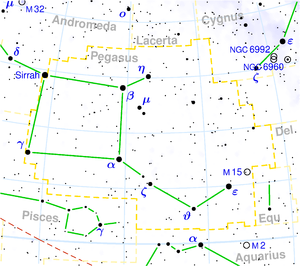
Sirrah - The blue-white star on the border of Andromeda and Pegasus. It is interesting in that in the past it belonged to two constellations and had dual designations: α Andromedae (Sirrah) and δ Pegasi (Alpherratz). Today, it is classified in the constellation of Andromeda, although with its brightness of 2.06 mag, it is also the brightest star in the Pegasus Square. It is located 97 light-years away.
Enif (ε Peg) - The brightest star of the constellation. In a small telescope, besides this orange giant of the second magnitude, a companion of 9th magnitude appears. In a large telescope, a companion of 11.3 magnitude is also added. Astronomers believed that Enif is a variable star, but this has not yet been definitively confirmed. It is located 690 light-years away.
Scheat (β Peg) - The red giant, whose brightness irregularly varies between 2.4mag and 2.6mag. This semi-regular variable star of spectral class M2 has a period of approximately 35 to 40 days. α and γ are suitable comparison stars. It is located 196 light-years away.
Matar (η Peg) - The main yellow component has a magnitude of 2.94 and is separated by 90.4" from a blue companion with a magnitude of 9.9. The blue companion is still a close binary, but the AB pair can be easily resolved in a telescope. The system is located 167 light-years away.
φ1 Peg - A beautiful, dark yellow star with four companions of brightness 10.1 mag, 10.6 mag, 11.9 mag, and 12.5 mag. Additionally, it forms a nice pair in binoculars with the yellow star φ2 Peg (4.3 m).
57 Peg - A beautiful pair consisting of a primary orange component (5.1 mag) and a blue companion (9.7 mag), located 32.6" away from the primary component.
M 15
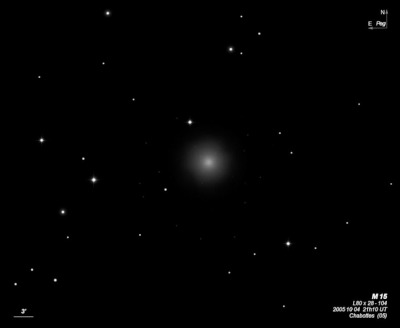
Jean-Dominique Maraldi discovered M15 = NGC 7078 = h2120 on 7 Sept 1746 at the Paris Observatory while tracking Comet de Cheseaux of 1746. Four nights later he discovered M2. Messier made an independent discovery on 3 Jan 1764, as well as Johann Bode on 23 Sep 1774.
William Herschel made an early observation using his 6-inch (10-ft focal length) on 31 May 1783 and commented, "all fairly resolved into stars." On 19 Oct 1784, he described "a beautiful cl. of v compressed and numerous stars, the most compressed part about 2' dia, the next about 7 or 8'; and all the stars within about 15' seem still to belong to the same by the colour, the size, the regular scattering and the gradual accumulation. The general figure is round; but within the space of 6 or 7' the stars are arranged in a sort of a square."
John Herschel reported "vB; vL; irreg. R; g b and v s m b M. A magnificent globular cluster; comes up to a perfect blaze in the centre, like a protuberance or nipple; not the condensation of a homogeneous globe; it has straggling streams of stars, as it were, drawing to a centre. It is not round. Has a * 8m, 30s following in parallel."
200/250mm - 8" very bright, large, intense core is very compact and dense, surrounded by inner halo with many stars superimposed, outer halo well resolved into long distinct streamers. A mag 7.6 star is at the NNE edge of the halo.
300/350mm - 13.1" very bright, very large, very small intense nucleus surrounded by a bright core. Superb resolution down to the center of core.
400/500mm - 17.5" (8/5/94): extremely bright with a halo extending to about 11' diameter and a 3' very bright core containing a 30" intense nucleus. The halo is very highly resolved into fairly bright stars although the stars are irregularly scattered in the outer halo. The halo extends 85% to mag 7.7 SAO 107179 just off the NNE edge of the halo and many stars in the halo appear to be arranged in loops and strings. The core is extremely densely packed with stars down to a very small intense glow at the center. This 30" nucleus is concentrated to the geometric center ("core collapse"). The faint planetary Pease 1 is situated just 30" NNE of center (see observation).
Naked-eye - (7/11/07): easily visible naked-eye at Lassen National Park as a small, hazy spot just west of a 6th magnitude star.
(7/26/06): Located 17' W of a naked-eye mag 6.1 star. The globular was sometimes visible naked-eye as a faint haze to the west of the star.
Notes by Steve Gottlieb
NGC 7331
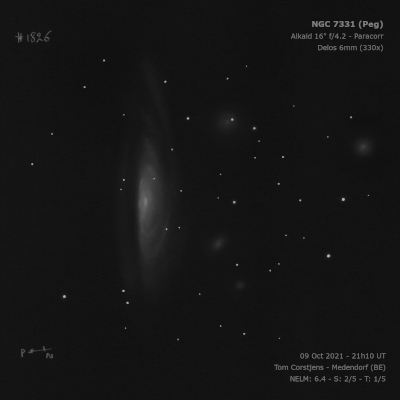
William Herschel discovered NGC 7331 = H I-53 = h2172 on 6 Sep 1784 (sweep 258) and recorded "pB, cL, E, lbM." His position is 10' too far south-southeast. On 13 Sep 1784 (sweep 269), he noted "vB, cL, mE, mbM, r." JH reported "vB; pL; smbM; E 70° np to sf; 90" l, 30" br. If I. 53, the working list 9' out in PD [it is]."
George Stoney, LdR's assistant on 17 Aug 1849, logged "the preceding edge is well defined [dust lane] and Nucl near it. I strongly suspected an eF branch [spiral arm] from south end round following and north and then preceding of preceding edge." A month later he confirmed "appendage preceding certain, following branch suspected, 4 knots [companions] following, one preceding seen by Lord R to consist of 4 or 5 stars [wrong]." The sketch on Plate XXX, fig 39, clearly shows the dust lane along the major axis.
200/250mm - 8" (8/28/81): very bright, large, nucleus bulge, very elongated. Two extremely faint companions to the east are just visible.
300/350mm - 13.1" (7/27/84): very bright, very elongated 3:1 NNW-SSE, 9'x2.5', very bright elongated core, substellar nucleus. The west side has a sharper edge due to dust. Four (background) companions are close following with the brightest three NGC 7335 3.5' ENE, NGC 7337 5.2' SE, NGC 7336 5.3' NE and NGC 7340 8.1' E of center. Stephan's Quintet lies 30' SSW. NGC 7331 is the brightest in a small group including NGC 7320 (in Stephan's Quintet).
400/500mm - 18" (8/1/08): The sharp light cut-off (dust lane) was evident, running along the west side of the galaxy, and the outer halo had subtle structure and variations in brightness that suggested spiral structure.
600/800mm - 24" (7/21/12): at 322x this showpiece galaxy appeared very bright, very elongated 3:1 NNW-SSE, ~9'x3'. Contains a very bright, elongated core that is sharply concentrated with an intense stellar nucleus. The galaxy exhibits subtle spiral structure in the outer halo and the brighter edge of the inner western arm is sharply defined as it shoots north. Just west of this arm the light drops off sharply due to a long dust lane and the dim glow of the outer halo is clearly visible west of the lane. Arm structure is also evident at the north and south ends of the central region. The four background companions to the east fit snugly in the field.
900/1200mm - 48" (10/24/14): at 488x, the long dust lane along the west side (running N-S) was very evident as the galaxy is sharply cut off at the bright edge of a thin inner spiral arm (the arm itself was not resolved). A clearly visible outer spiral arm curves sharply counterclockwise around the south side of the halo and shoots directly north. It continues or merges into a fairly narrow arm just west of the dust lane and extends north of the central region on the west side.
Notes by Steve Gottlieb
NGC 7217
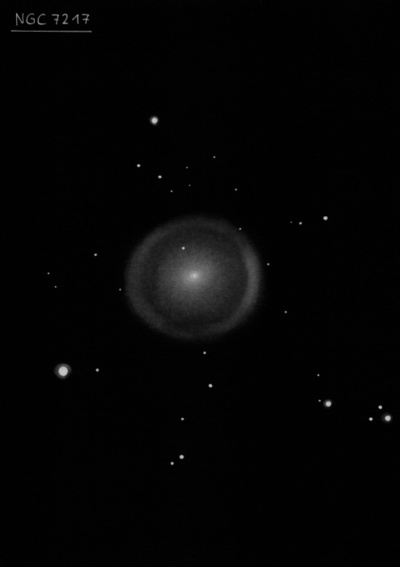
William Herschel discovered NGC 7217 = H II-207 = h2149 on 7 Sep 1784 (sweep 259) and recorded "R, mbM, cL, er, the brightness diminishing gradually." JH made the single observation "B; R; 30"; gbM." and measured an accurate position. The Birr Castle observers felt this object was resolvable -- and there are several faint stars involved or at the periphery. On 16 Sep 1854, R.J. Mitchell logged "there can hardly be a doubt that this neb is a Cl; some stars near centre seen by Lord R. with one-inch single lens [power 650] and filaments of stars at times suspected running out from the nucleus."
200/250mm - 8" fairly bright, round, moderately large, bright core.
400/500mm - 17.5" (9/2/89): very bright, fairly large, round, dominated by small very bright core, surrounded by larger halo. A mag 10.5 star is 3.2' SE of center.
Notes by Steve Gottlieb
NGC 7814
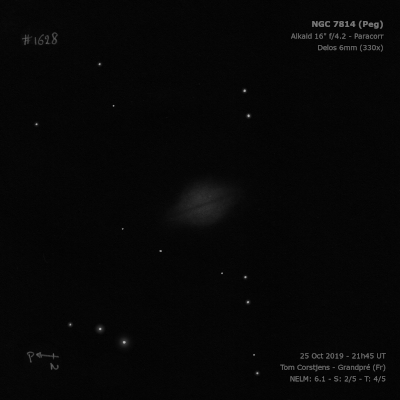
William Herschel discovered NGC 7814 = H II-240 = h2297 on 8 Oct 1784 (sweep 286) and logged "pF; pL; irr R; easily res." John Herschel made the single observation "B; L; irreg R; vgbM; 2' or 3' diam; no nucleus." R.J. Mitchell, LdR's assistant on 12 Oct 1885, wrote "pL and B, E, gmbM, a decided dark lane runs through it in the direction of the major axis. The neb is rather narrower in the middle of its length and spreads out laterally towards its extremities, fading away gradually. His sketch was included in the 1861 publication and in Plate 5, Fig 11 in the 1880 Lawrence Parsons publication. The sketch shows the thin dust lane bisecting the core and extending out through the arms.
200/250mm - 8" (11/8/80): moderately bright, slightly elongated.
300/350mm - 13.1" (10/10/86): bright, large, large bright core, elongated NW-SE, faint stellar nucleus.
400/500mm - 17.5" (8/2/86): very bright, very bright large core, fainter extensions NW-SE. Forms a pair with IC 5381 10' S. The narrow dust lane bisecting the galaxy was not seen. IC 5378 (Arp 130) lies 30' NNW.
17.5" (12/19/87): faint stellar nucleus visible.
900/1200mm - 48" (10/23/11): gorgeous view of this showpiece edge-on spiral at 375x and 488x. The oval central bulge was large and very bright, increasing to an intense core. A very thin, very high contrast dust lane sliced through the major axis of the galaxy, neatly bisecting the galaxy. On close inspection, the halo on the south side of the lane was marginally more extensive. At the center, a small nucleus is apparently obscured, leaving only two very small brilliant "knots" on either side of the lane. Beyond the central region, much fainter arms extend NW and SE, increasing the total size to 5'x1.5'. The dust lane was easily visible splitting the edge-on arms until they dimmed out at the tips.
Notes by Steve Gottlieb
NGC 7479
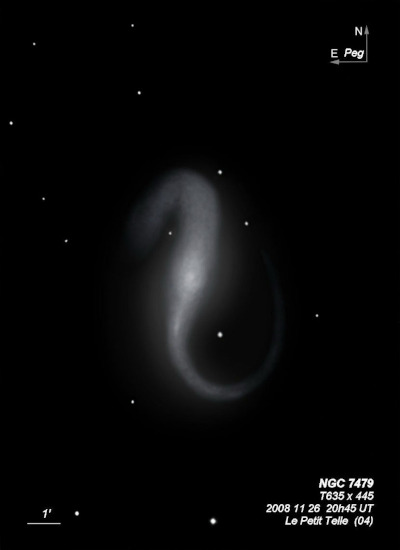
William Herschel discovered NGC 7479 = H I-55 = h2205 on 19 Oct 1784 (sweep 299) and noted "F, mE, r, near 3' in length and about 1' in breadth; I see 2 or 3 stars in it; but they do not seem to belong to it." On 23 Nov 1785 (sweep 476) he noted "cB, mE nearly in the direction of the meridian; about 4' long, about 2' broad, gbM." A sketch was published in 1811.
Lord Rosse or his assistant George Johnstone Stoney sketched NGC 7479 on 10 Sep 1849 (figure 4 in the 1850 PT paper). The sketch shows a single prominent spiral arm wrapping nearly completely back to the bar, though the form was uncertain: "Spiral, but query whether this is not more properly an annular than a spiral nebula." Tempel, John Herschel and d'Arrest made additional sketches.
In the 1900 paper "The spiral nebula H I 55 Pegasi" (1900ApJ....11....1K), Lick astronomer James Keeler compared the various sketches of NGC 7479 with the photograph taken with the Crossley reflector to demonstrate the subjectivity of sketches and their limitations compared to photographs.
300/350mm - 13.1" (9/29/84): fairly bright, elongated ~N-S. Strong impression of a dark lane or gap on the west wide and brief hints of haze beyond this gap, particularly around the south end towards the west (spiral arm).
13.1" (11/5/83): fairly bright, elongated N-S, bright core. Two faint stars are west and north.
400/500mm - 17.5" (7/19/90): this is one of few northern barred spirals in which the structure is clearly visible. A bright bar is oriented N-S with a bright core and nearly stellar nucleus. A mag 13 star is off the north edge 1.4' from center and a fainter mag 14 star is 47" SW of center. A thin curving spiral arm attached at the south end curves to the west and then north beyond the mag 14 star SW of the core. This arm parallels the bar along the west side about 90°. At the Sierra Buttes, the spiral arm was held almost continuously with averted vision. Located 3.3' NNE of a mag 10 star.
17.5" (10/12/85): thin curving arm clearly seen attached at the SW end curving to the north around a faint star.
900/1200mm - 48" (11/2/13, 10/30/16 and 10/28/19): The view of NGC 7479 was mesmerizing at 488x and 610x. Compared to the view last October, I noticed the fainter eastern arm was broader (split in two parallel branches on images) and although diffuse, obviously extended all the way to the southern edge of the galaxy, nearly reaching a mag 16 star. Also the bright arm on the western side of the bar dimmed as it extended north, but wrapped all the way or just beyond a mag 15.7 star situated 48" SW of the bright mag 12.5 star off the north end of the bar. The western arm clearly had a clumpy appearance with a couple of brighter patches. Near the south end of this arm [1.1' SSW of center] is a very faint quasi-stellar knot, which is catalogued as HII region #45 in Hodge and Kennicutt's 1983 "An Atlas of H II regions in 125 galaxies". Another brighter knot, ~12"x6", is at the southwest end of the arm [1.5' SW of center]. This is region #57 in the HK Atlas. A faint edge-on (V = 17.8), lies 3.5' NW of NGC 7479.
48" (10/22/11): NGC 7479 is probably the best barred spiral in the northern sky. At 488x and 610x the central bar appears very bright and extended over 2' N-S. The bar had a mottled appearance, bulging slightly in the center, was broadly concentrated with a small bright core. A bright mag 12.5 star is at the north end of the bar, 1.3' from the center.
At the northern end, an arm emerges from the bar and begins to curve counterclockwise to the east, but abruptly dims and merges with the halo on the east side. At the south end of the bar, a beautiful sweeping arm wraps counterclockwise around the south of a superimposed mag 13.5 star, extending to the west side of the core. This prominent arm dims and ends just north of an extremely faint HII knot (stellar) in the arm, which is catalogued as object #4 in Rozas' et al 1999 A&AS paper "Global properties of the population of HII regions in NGC 7479 from photometric H-alpha imaging". A mag 16.4 star is 0.7' due west (outside the arm) of this knot. A mag 15.7 star is also superimposed between the faint HII knot and the bright star at the north end.
Notes by Steve Gottlieb
NGC 7332
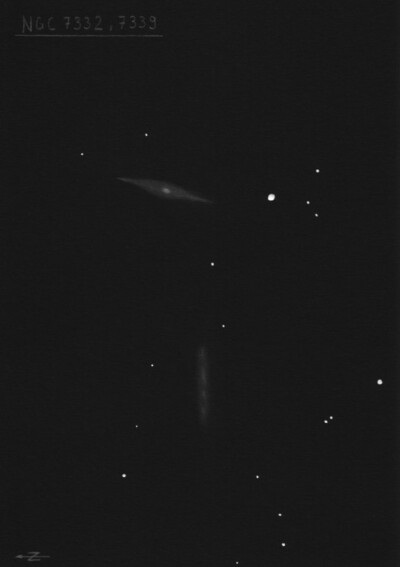
William Herschel discovered NGC 7332 = H II-233 = h2173, along with NGC 7339, on 19 Sep 1784 (sweep 278) and recorded "pB, E, easily resolvable. I can distinguish one or two stars." On 20 Oct 1784 (sweep 302) he reported "B, lE, the direction nearly in the parallel [N-S]." John Herschel's first observation (sweep 166) reads, "B; S; mE in pos = 163° by microm; vsmbM to a * 11m."
200/250mm - 8" (7/24/82): fairly bright, small bright nucleus, edge-on NNW-SSE. Forms a pair with NGC 7339 5' E.
400/500mm - 17.5" (9/2/89): bright, fairly large, edge-on 4:1 NNW-SSE, well-defined very bright core, stellar nucleus. A mag 11 star is 2.4' SSE of center, collinear with the major axis. Forms a striking pair of edge-on systems with NGC 7339 5.2' E!
Notes by Steve Gottlieb
NGC 7619
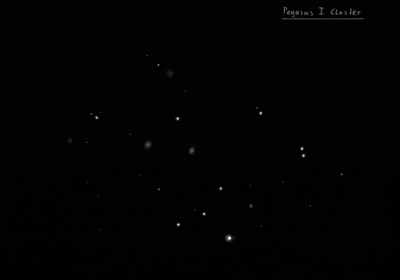
William Herschel discovered NGC 7619 = H II-439 = h2230 on 26 Sep 1785 (sweep 442) and recorded "vF and vS." His position is accurate. John Herschel made two observations, reporting "pB; R; bM; 30"." (sweep 89) and "B; pL; R; psbM." (sweep 280)
NGC 7619 was the most distant known galaxy mentioned by Hubble in his 1929 paper "A relation between distance and radial velocity among extra-galactic nebulae", although it's recessional velocity of +3779 km/sec wasn't used in his graph of the velocity-distance relationship. Hubble mentioned a preliminary distance of 25 million l.y.
200/250mm - 8" (9/25/81): faint, small, small bright nucleus.
300/350mm - 13.1" (9/22/84): bright, small prominent core, largest in cluster.
400/500mm - 17.5" (9/14/85): bright, elongated, bright core, stellar nucleus. This galaxy is the brightest and largest member of the Pegasus I cluster along with NGC 7626 6.9' E. Forms a close pair with NGC 7617 2.8' SSW. NGC 7626 lies 11.0' E and difficult UGC 12518 lies 9.4' NW.
Notes by Steve Gottlieb
NGC 7626
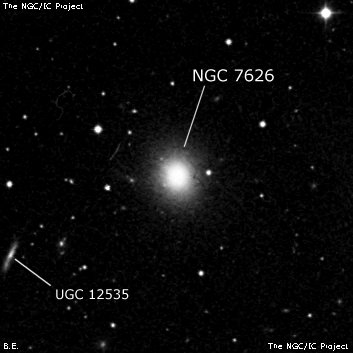
William Herschel discovered NGC 7626 = H II-440 = h2233 on 26 Sep 1785 (sweep 442) and recorded "pB, pS, bM." His position is accurate. JH made two observations, "pB; R; bM; 30"." (sweep 89) and "B; R; pL; psbM" (sweep 280).
200/250mm - 8" (9/25/81): faint, small, bright core. A mag 6.5 star is at the south edge of the 40' field.
300/350mm - 13.1" (9/22/84): bright, small prominent core, fainter halo, similar to NGC 7619.
400/500mm - 17.5" (9/14/85): bright, slightly elongated 4:3, brighter core (although less intense than NGC 7619), substellar nucleus. A mag 14.3 star is less than1' W. NGC 7626 is the second brightest in the Pegasus I cluster and appears similar to NGC 7619 6.9' W.
Notes by Steve Gottlieb
NGC 7177
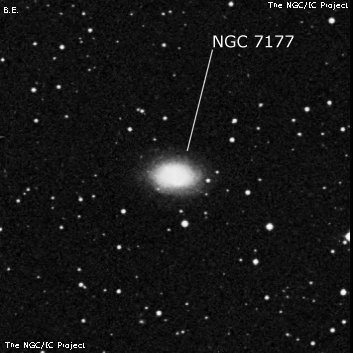
William Herschel discovered NGC 7177 = H II-247 = h2139 on 15 Oct 1784 (sweep 290) and recorded "pB, nearly R, bM, r, about 1' dia." On 11 Oct 1825, JH reported "pB; R; gbM; 60"-90" diameter." R.J. Mitchell sketched this galaxy on 31 Aug 1854 (included in the LdR 1861 publication). A total of 19 observations were made at Birr Castle.
300/350mm - 13.1" moderately bright, brighter core, elongated WSW-ENE.
400/500mm - 17.5" (8/5/91): very bright, moderately large, elongated 2:1 E-W, 2'x1'. Unusual appearance as the very bright core is elongated at nearly a 45° angle (SW-NE) to the major axis and contains a stellar nucleus. There is a hint of an irregular surface brightness in the outer halo.
Notes by Steve Gottlieb
NGC 7457
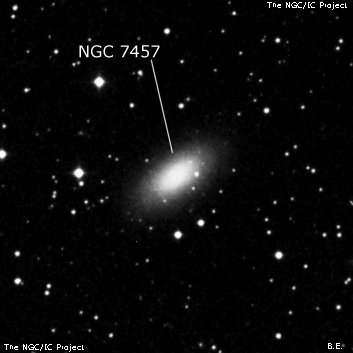
William Herschel discovered NGC 7457 = H II-212 = h2201 on 12 Sep 1784 (sweep 267) and recorded "pB, pL, lE, mbM, r. South of 2 faint stars. Some stars visible in it." His position is just off the west side of the galaxy. JH made a single observation, "B; L; lE; pgbM; 60"; has a stellar point in the centre." The observers at Birr Castle noted a star involved just preceding the nucleus.
400/500mm - 17.5" (8/13/88): bright, fairly large, elongated 2:1 NW-SE, very bright core, very small bright nucleus. Forms a pair with UGC 12311 8' NE (logged as "very faint, fairly small, elongated NW-SE, even surface brightness"). Several bright stars in field including two mag 10 stars 3.5' NE and 2.8' E. A mag 11 star is 5.0' ENE and mag 9 SAO 90959 9.5' ENE.
Notes by Steve Gottlieb
NGC 7743
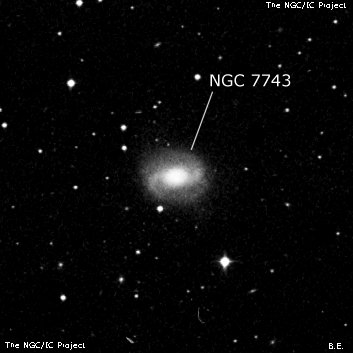
William Herschel discovered NGC 7743 = H II-256 = h2265 on 18 Oct 1784 (sweep 297) and logged "R, like the foregoing [NGC 7742], but rather fainter." His position matches UGC 12759. JH observed this galaxy on 3 sweeps and noted (sweep 305) "pB; R; psbM; 15"; has a * 15m, dist 1'; pos = 153.8° by micrometer." Samuel Hunter, LdR's assistant on 10 Sep 1860, commented "Is it connected with the * sf by a branch from the north side of neb?" This branch is a spiral arm that extends south towards the star on the east side of the galaxy.
200/250mm - 8" (8/17/82): faint, elongated, small bright nucleus, faint halo with averted. A mag 13 star is off the SE edge.
400/500mm - 17.5" (10/28/89): moderately bright, fairly large, slightly elongated NW-SE, prominent core, stellar nucleus. A mag 13 star is at the southeast edge 1.0' from center. A mag 10 star is 2.8' SW.
Notes by Steve Gottlieb
NGC 7742
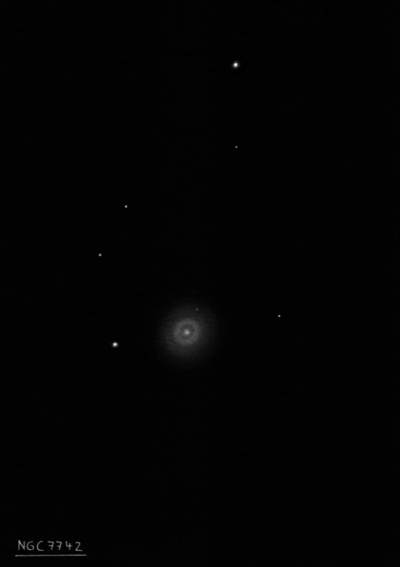
William Herschel discovered NGC 7742 = H II-255 = h2264 on 18 Oct 1784 (sweep 297) and recorded "pB, pS, R, bM, r." CH's reduced position is 11 sec of RA west of UGC 12760. He found the galaxy again on 23 Nov 1785 (sweep 477) and noted "pB, R, gbM." JH observed this galaxy on 5 sweeps and logged (sweep 14), "B; R; gmbM; 60"; has a small * one diameter following."
200/250mm - 8" (8/17/82): faint, small, round, small bright nucleus. A mag 12 star is very close east. NGC 7743 lies 50' S.
400/500mm - 17.5" (10/28/89): moderately bright, moderately large, round, bright core. A mag 12 star is 1.1' ESE of center (outside halo).
Notes by Steve Gottlieb
NGC 7678
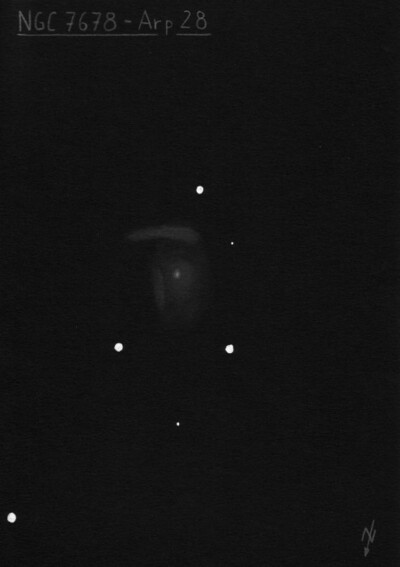
William Herschel discovered NGC 7678 = H II-226 = h2245 on 15 Sep 1784 (sweep 274) and recorded "F, pL, bM, elliptical, between an acute triangle of pretty considerable stars." On sweep 91, JH described this object as "F; vR [sic?]; pL; lbM; very symmetrically situated in the southern part of a lozenge of 4 stars, on the longer diagonal, forming an elegant object." He included a sketch in the Slough catalogue (fig. 85).
On 5 Nov 1850, Lord Rosse's assistant George Johnstone Stoney reported "I saw two knots and a dark space between them [gap between nucleus and southern arm]. I think the nebula is connected above the dark space." R.J. Mitchell, observing in 1854, noted "spirality distinctly seen. I thought the coil double in more closely upon itself than shown in Mr. Stoney's drawing, and that the central knot had a stellar nucleus. The whole nebula looked sparkling, though I could not see any separate stars."
300/350mm - 13.1" (9/9/83): faint, moderately large, diffuse, slightly elongated ~N-S, 1.8'x1.4', weak concentration. Located within a thin isosceles triangle of mag 10.5-11 stars with the vertex at the south end and height 2.5'. The mag 11 star just off the south end is just 1.1' from the center.
600/800mm - 24" (10/5/13): NGC 7678 is in the Arp group of "spiral galaxies - one heavy arm", which is evident visually. At 260x the galaxy is beautifully framed with a thin triangle of mag 11.3/11.4 stars to the north and a mag 12 star off the south end. It appeared fairly bright, moderately large, elongated SW-NE, ~1.8'x1.3'. Contains a brighter elongated core that increases to a very small brighter nucleus. The "heavy arm" is visible on the south side as a thin, shallow arc in the outer halo and brightens right at its western tip.
900/1200mm - 48" (10/27/16 and 10/28/19): at 610x; very bright, fairly large, slightly elongated SSW-NNE, 2.0'x1.5'. Contains and small bright core and an extremely bright, very small nucleus with a pinpoint stellar peak. The core is elongated WNW-ESE and appeared as a weak bar. A bright thin arm was nearly attached on the east side of the "bar" and swung counterclockwise to the south of the core. This arm was sharply defined and brightened significantly on the southwest end [~30" SW of center]. The northern arm was only visible at its root near the west end of the "bar" as well as a small, detached piece on the northeast side of the halo [30" NE of center]. The galaxy sits within a bright isosceles triangle of mag 11/12 stars. The observation was made in good seeing but through thin clouds.
Notes by Steve Gottlieb
UGC 12613
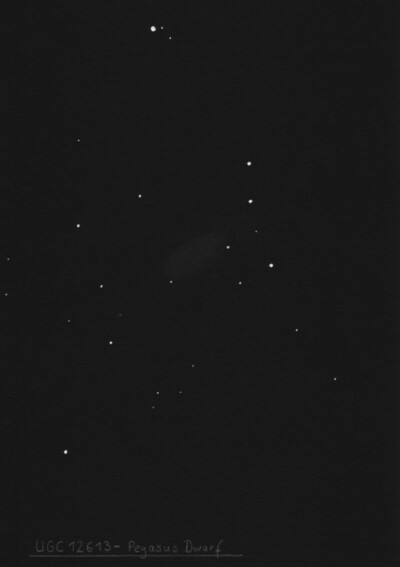
400/500mm - 17.5" (10/25/97): this difficult Local Group member (M31 subsystem) was not seen at 220x. At 100x a very low surface brightness hazy region with no concentration was visible just following a trio of mag 12 stars. It was very difficult to estimate the dimensions and orientation as the halo gradually faded into the background but the faint glow appeared roughly 4'x2', extended WNW-ESE. Also viewed at 140x, although no other details were seen. I would have passed right over this object without a finder chart and use of low power.
600/800mm - 24" (10/5/13): picked up at 200x as a faint, large, very diffuse elongated glow with a couple of stars superimposed. This Local Group dwarf appeared roughly 4.0'x2.0', extended WNW-ESE. The surface brightness is quite low and fairly even, except for a slightly brighter 30" patch (core?) near the center. A mag 14 star is just within the ESE end (the patch is ~1' WNW of this star) and a brighter mag 12.7 star is embedded on the south side of WNW end.
900/1200mm - 48" (10/28/19): at 375x; faint, very large, low surface brightness glow, easily seen but featureless except for a relatively large slightly brighter central region [~1.5' in diameter]. The edges of the halo faded out without any definite edge but perhaps extended 4'x2' WNW-ESE. A mag 12.8 star is along the south side of the WNW end. The glow seems to extend beyond a mag 14.4 star on the ESE end.
LEDA 214961, easily visible 1.6' SSW of center, appeared faint (at low power), fairly small, very elongated 4:1 ~E-W, thin streak, 25"x6".
IV Zw 152, situated off the ESE end [4.4' from center], was nearly moderately bright, fairly small, round, well defined halo extending 20"-24", moderately high surface brightness.
Notes by Steve Gottlieb
NGC 1
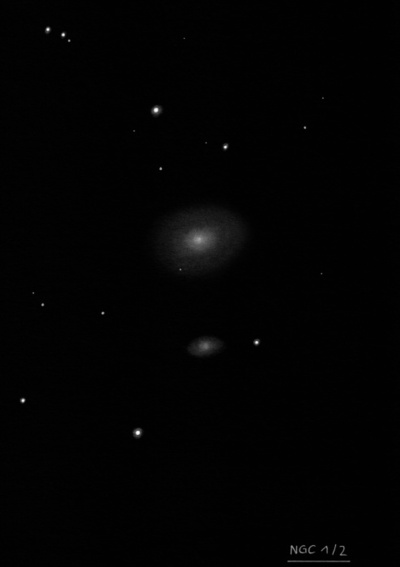
Heinrich d'Arrest discovered NGC 1 on 30 Sep 1861 while testing the 11-inch f/17.5 Merz refractor of the Copenhagen Observatory, though he missed nearby NGC 2. This was his first deep sky discovery, though d'Arrest was uncertain if his object was identical to h4 or h5 (both of which refer to NGC 16). He described (combination of 4 observations) NGC 1 as "faint, small, round, 20", no concentration. In a straight line connecting two stars 11 and 14 mag." Herman Schultz also observed NGC 1 three times in 1866 and 1868 with a 9.6-inch refractor at Uppsala and also missed fainter NGC 2. The NGC 1 and 2 visual pair are not physically related. NGC 1 lies at a distance of ~200 million l.y. with NGC 2 at roughly 320 million l.y.
300/350mm - 13.1" (8/24/84): fairly faint, very small, small bright core.
13.1" (11/5/83): faint, very small. Forms a pair with NGC 2 2' SSE.
400/500mm - 17.5" (11/14/87): moderately bright, slightly elongated ~E-W, bright core, stellar nucleus. Forms a pair with NGC 2 just 1.8' S.
17.5" (9/19/87): fairly faint, oval 3:2 ~E-W, small, bright core, stellar nucleus. A mag 12 star lies 1.9' NNE and a mag 13 star is 1.5' NNW of center.
Notes by Steve Gottlieb
NGC 7094
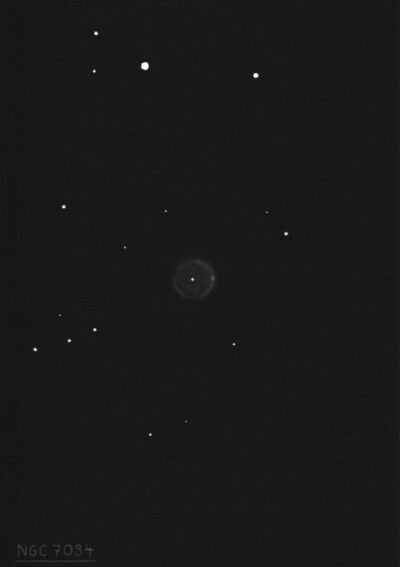
Lewis Swift discovered NGC 7094 = Sw. II-88 on 10 Oct 1884 and recorded "nebulous star; B *; in eeF nebulosity; v diff.; nearly pointed to by 3 st. in a line." His RA is 34 seconds too small. He added in a footnote, "This is a prototype of GC 4634 [NGC 7023] and several others, and of No. 7 of my Catalogue No. 1 [NGC 2247], which differs from most nebulous stars by being exactly in the center of circular nebulous atmospheres of uniform brightness." Wolfgang Steinicke mentions that Swift called this object "the most wonderful of all [nebulous stars] - in fact it is the only instance known to me - for instead of the central star being single, it is double." There is a second star involved but it is not central, rather displaced to the northeast edge.
Lubos Kohoutek rediscovered NGC 7094 during a visual survey of the POSS and included it in a list of new PN (K 1-19) published in 1963.
300/350mm - 13" (6/18/85): at 62x with filter appears faint, moderately large, round. Without a filter the faint mag 13.7 central star is visible surrounded by a very low even surface brightness halo 1.5' in diameter.
400/500mm - 17.5" (10/2/99): at 100x and OIII filter appears fairly faint, round, moderately large, 1.5' diameter, even glow. At 220x without filter, the central star is easily visible surrounded by a round, low surface brightness glow. A very faint star is at the NE edge. No annularity seen.
600/800mm - 24" (8/31/16): excellent view at 200x using a NPB filter. The 90" disc was fairly crisply defined and contained a bright central star (mag 13.5), even through the filter. Unfiltered, a mag 14.5-15 star was visible at the NE edge. The planetary apppeared weakly annular and brighter in a 90° arc along the west side. There appeared to be a knot or local brightening right at the west edge of the rim. Located 1.8° NE of M15.
The compact galaxy II Zw 141 lies 6' WNW. It appeared faint, very small, round, 12" diameter. On the DSS a mag 15.2 star is at the southwest edge (6" separation from the center of II Zw 141) and probably the galaxy + star were merged visually.
Notes by Steve Gottlieb
NGC 7752
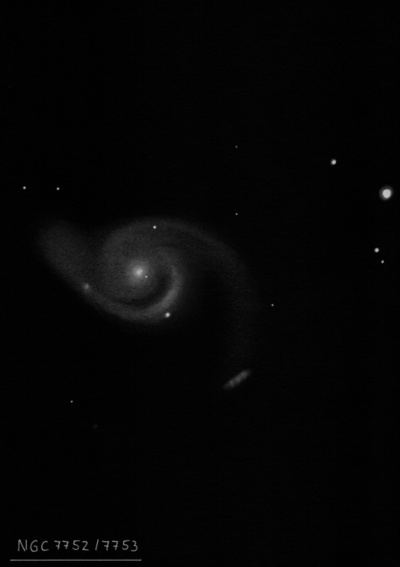
R.J. Mitchell discovered NGC 7752 on 22 Nov 1854 while observing NGC 7753 at Birr Castle He noted "south preceding NGC 7753] is a vS oblong nebula, resolvable?" It was observed again in 1857, but no offset or sketch was made. Heinrich d'Arrest independently found this galaxy on 24 Sep 1865, though confused the orientation and placed NGC 7752 1.5' north of NGC 7752, instead of 1.6' south. As a result the relative positions in the NGC are incorrect.
300/350mm - 13.1" (9/22/84): faint, very small, elongated ~E-W. Forms a close pair with brighter NGC 7753 2' NE. A mag 14 star is 1.2' NE of center and situated between the galaxies.
400/500mm - 18" (7/14/07): fairly faint, fairly small, elongated 3:2 WNW-ENE, 0.5'x0.3', even surface brightness. Fainter of a double system (attached at end of spiral arm) with NGC 7753 just 2' NE. A mag 14 star lies between the two galaxies
900/1200mm - 48" (10/28/19): at 375x and 542x; bright, elongated 2:1 WNW-ESE, 0.6'x0.35', irregular shape, large bright core that bulges at the center. Situated at the end of the western spiral arm of NGC 7753 [2.0' SW of center].
Notes by Steve Gottlieb
UGC 11964
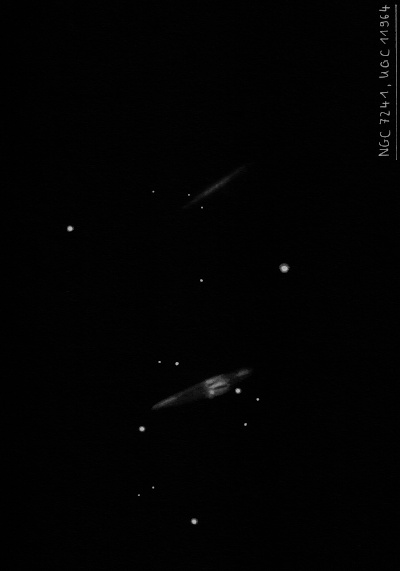
400/500mm - 18" (8/11/10): threshold object, just glimpsed at 262x and 285x. Too faint to see its needle-like shape clearly though occasionally seen as a streak, perhaps 20"x6" but not the full 2' extent. Located 2.2' NW of a mag 10.4 star which detracts a bit from viewing and 5' W of NGC 7241.
Notes by Steve Gottlieb
NGC 7741
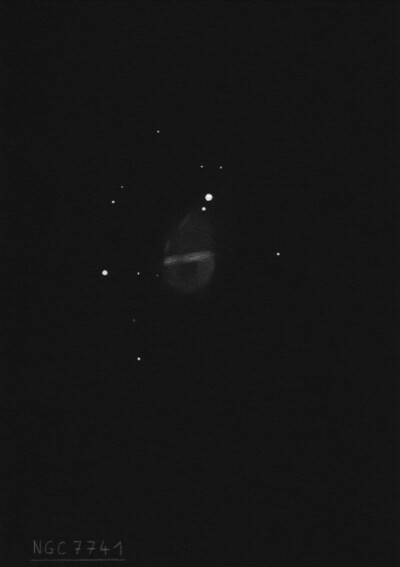
William Herschel discovered NGC 7741 = H II-208 = St XII-95 on 10 Sep 1784 (sweep 264) and recorded "F, cL, R, brightest in the middle; the brightness diminishing by very gradual shades, sf a star (of the 10 or 11 magnitude by memory)." His position is 4' northwest the center of UGC 12754. Heinrich d'Arrest observed the galaxy on 6 nights (first on 1 Sep 1864), noted the error in WH's position, and accurately measured the offset to the double star off the northwest side.
Édouard Stephan independently discovered this galaxy on 25 Oct 1881, also measured an accurate micrometric position and recorded "eF, fairly large, irr oval, elong E to W, two points of condensation." In the remarks section at the end of the list, Stephan notes this object is identical to GC 5005 [NGC 7741], but WH's position was poor. Perhaps while preparing his manuscript, he read d'Arrest's observations. The 10 Dec 1873 observation at Birr Castle reads "cB, L, mE 108°, much diffused neby south and following, which Lord Rosse suspected to be divided into branching [spiral] arms."
300/350mm - 13.1" (9/9/83): faint, moderately large, diffuse, elongated ~N-S. A pretty double star mag 9/11 at 24" is just off the north edge 2' from center and interferes with viewing.
600/800mm - 24" (8/30/16): at 226x; bright, fairly large, dominated by a central bar extending at least 3:1 E-W, ~45"x15". A very low surface brightness arm is attached at the west end of the bar and extends to the south. The corresponding arm extending north on the east end was less obvious and only marginally glimpsed. The arms blend into a low surface brightness halo at least 2' in diameter. A nice mag 9.8/12 double star is off the NW side 2' from center.
Notes by Steve Gottlieb
NGC 7448
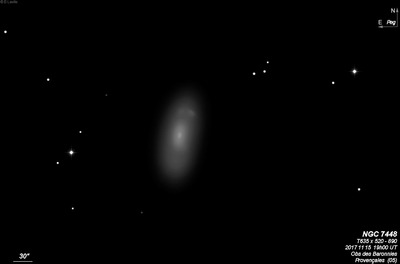
William Herschel discovered NGC 7448 = H II-251 = h2199 on 16 Oct 1784 (sweep 294) and recorded "pB, cL, E, r." On his sweep 11, JH logged "pB; L; vgbM; E pos 85° np to sf." His mean position is accurate. Ralph Copeland commented it was "slightly concave towards p side" in a 1873 observation at Birr Castle. Christian Peters also measured an accurate position.
200/250mm - 8" (9/25/81): faint, small, elongated. NGC 7454 is located 29' NNE.
300/350mm - 13.1" (9/22/84): fairly bright, broad moderate concentration, thin fainter extensions NNW-SSE. Does not contain a well-defined nucleus.
400/500mm - 17.5" (9/19/87 and 9/14/85): bright, large, elongated 2:1 NNW-SSE, small bright core, fainter extensions. Brightest in the NGC 7448 group.
900/1200mm - 48" (10/26/16 and 10/28/2019): at 610x; very bright, large, elongated ~2:1 N-S, 2'x1', interesting structure with knots. The central portion is brighter along the major axis like a weak bar and in the center is a small, very bright nucleus. A bright, prominent knot, 10"-12" diameter, is just west of the northern tip of the galaxy and a weak knot is close east [by ~15"]. The northern half of the galaxy is generally brighter with a slightly mottled surface. The galaxy has a weak enhancement along the southwest edge of the halo [spiral arm] and a fairly faint knot is on the southeast side [40" SE of center]. Overall, the southern part of the halo has a lower, more uniform surface brightness.
Notes by Steve Gottlieb
NGC 7385
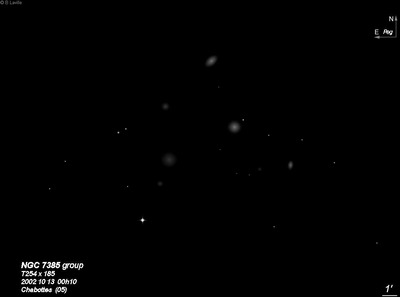
William Herschel discovered NGC 7385 = H III-216 = h2183, along with III-217 = NGC 7386, on 18 Oct 1784 (sweep 297) and recorded both as "Two, vF, S, R, r, about 5' distant from each other. The position is that of the last or north following NGC 7386]." On 23 Nov 1785 (sweep 476) he noted "vF, pS, R, vlbM, not far south of a small star." JH made two observations and recorded on sweep 304 "pB; R; 20"; has a *11m near. The preceding of two neb. The * by diagram is 1 radius of the neb np its edge."
400/500mm - 17.5" (7/4/86): moderately bright, broadly concentrated halo, small bright core, slightly elongated ~N-S. A mag 11 star is 1.0' NW. Brightest in a group with NGC 7383 5.6' SW, NGC 7384 ~5' SSW, NGC 7386 5.8' NNE, NGC 7387 5.9' ENE, NGC 7389 5.9' ESE and NGC 7390 7.7' SE.
600/800mm - 24" (7/30/16): at 260x; moderately to fairly bright, slightly elongated SW-NE, ~1.3'x1.0', moderate concentration with a bright core that gradually increases to the center. A mag 11.5 is just off the NW edge, 1.0' from center. Brightest in a group (WBL 688, the core of ZwCl 2247.3+1107 at roughly 360 million l.y.) with 6 NGC galaxies and numerous additional fainter galaxies. Only slightly fainter NGC 7386 is 5.8' NNE.
Notes by Steve Gottlieb
NGC 7769
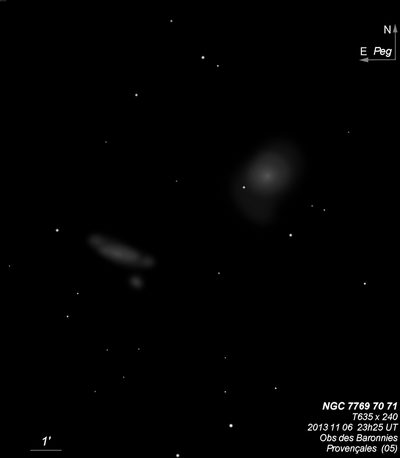
William Herschel discovered NGC 7769 = H II-230 = h2274, along with NGC 7771, on 18 Sep 1784 (sweep 277) and logged "F, pL, R, bM, r." On 13 Nov 1786 (sweep 635) he noted "cB, pL, iF, mbM." JH reported "pB; S; R; bM; the np of two [with NGC 7771]."
300/350mm - 13.1" (9/9/83): fairly bright, moderately large, round, bright core.
400/500mm - 17.5" (8/31/86): bright, moderately large, round, 1.5' diameter, brighter core, sharp stellar nucleus. A mag 13 star is 2.1' SSW. This galaxy is the brightest in a compact quartet with the NGC 7770/NGC 7771 pair 5' ESE and CGCG 455-055 6' NNE.
600/800mm - 24" (10/5/13): at 260x; bright, fairly large, round, 1.6' diameter, sharply concentrated with a very bright core and stellar nucleus. The low surface brightness outer halo (spiral arms) is slightly elongated and gradually fades out. Brightest in a trio (KTG 82) with NGC 7770 and 7771 (1' pair) both 4.5' SE.
Notes by Steve Gottlieb
NGC 23
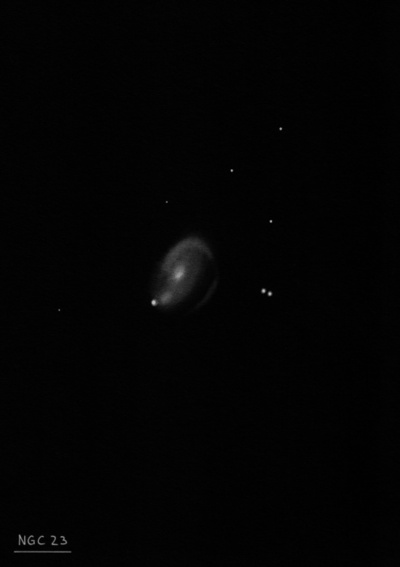
William Herschel discovered NGC 23 = H III-147 on 10 Sep 1784 (sweep 264) and recorded as "2 or 3 stars in a line, with seeming nebulosity between them." I only noted a single superimposed star, though the second "star" may be the nucleus. Dreyer observed the galaxy on 21 Nov 1875 using LdR's 72" and described a "vS neb, with a starlike nucl = 11-12 mag and a *13 in PA 135.2°. Dist 26.2"." The NGC position matches UGC 89 (Englemann measured an accurate position, in Astronomische Nachrichten 2485).
200/250mm - 8" (7/24/82): faint, small, elongated NW-SE, stellar nucleus. A star is at the SE end.
400/500mm - 17.5" (11/14/87): fairly faint, fairly small, elongated NNW-SSE, diffuse. Unusual appearance as a mag 14 star is superimposed 26" SE of center. Forms a pair with NGC 26 9' SE. Brightest member of a group (LGG 002) at a distance of ~200 million l.y.
Notes by Steve Gottlieb
NGC 7625
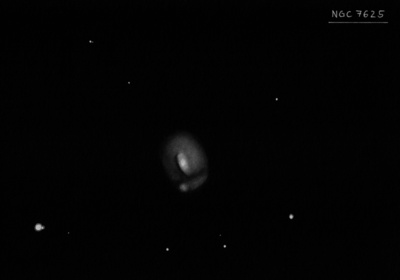
William Herschel discovered NGC 7625 = H II-250 = h2232 on 15 Oct 1784 (sweep 290) and recorded "F, lE, followed by a very bright star." He made another observation on 29 Nov 1785 (sweep 480) and noted "cB, S, R, mbM." On 7 Oct 1825 (sweep 11), John Herschel logged "B; R; sbM; 60"." A total of 8 observations were made at Birr Castle, mostly commenting on the irregular surface brightness. On 27 Sep 1857, Mitchell logged "south edge certainly brighter than the other, and a * or nucleus near that side, perhaps vF neby outside the s edge [the piece is cut off by dust]."
300/350mm - 13.1" (9/9/83): fairly bright, small, round, bright core. The dust lane on the southwest side was not seen. Located 6.8' WSW of mag 6.6 SAO 108560.
600/800mm - 24" (8/30/16): at 375x; bright, moderately large, roundish, well concentrated with a large bright core that is irregular and mottled and a small nucleus. The halo is much fainter and extends at least 1.0' diameter. With careful viewing I had the impression there was two close nuclei or perhaps a knot was close to the nucleus. The DSS and SDSS shows at least two intersecting dust lanes, though this feature was not confidently seen.
24" (9/10/15): at 260x; fairly bright, fairly small, round, ~40" diameter, small bright core that increases to a quasi-stellar nucleus. The absorption lane on the southwest side was not seen in poor transparency.
900/1200mm - 48" (10/28/19): viewed at 375x through thin clouds; very bright, fairly large, round, ~1.25' diameter, strong concentration with a very bright, slightly elongated or oval core. A low contrast dust lane wraps along the eastern edge of the core around to the south. The dust lane continues slicing through the galaxy towards the west, cutting off a southern piece of the galaxy, which mimicks the appearance of a broad spiral arm. A slightly brighter knot or patch is at the east end of this section, about 20" S of center. The outer halo was slightly fainter on the southeast side. Note: On the SDSS, there are two distinct, intersecting dust lanes, east and southwest of the core.
Notes by Steve Gottlieb
NGC 7497
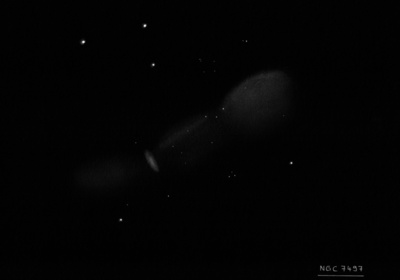
On deep images, NGC 7497 resides in a remarkable streak of "Integrated Flux Nebula" in Pegasus. IFN, also known as Galactic Cirrus is dust and gas outside the plane of the Milky Way. It dimly shines by reflected light (blue) as well as fluoresced by ultraviolet light of massive stars within the disk of our galaxy.
William Herschel discovered NGC 7497 = H III-203 = h2209 on 15 Oct 1784 (sweep 290) and recorded "vF, E, considerably L, about 2' long." JH made two observations: "eF; E like the tail of a comet; lbM." (sweep 11) and "vF; mE; pos 45° nf to sp; 4' l, 1' br." (sweep 92).
400/500mm - 17.5" (9/2/89): fairly faint, fairly large, very elongated 3:1 SW-NE, brighter middle, fairly low surface brightness.
Notes by Steve Gottlieb
NGC 7469
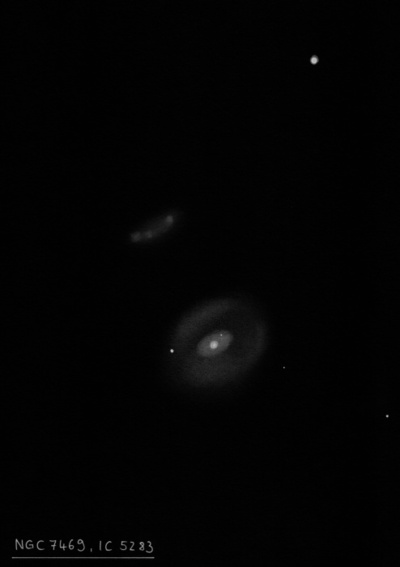
William Herschel discovered NGC 7469 = H III-230 = h2204 on 12 Nov 1784 (sweep 313) and noted "eF, eS, but 240 left a doubt." He found it again on 26 Sep 1785 (sweep 442) and logged "suspected a small irregular patch with seeming nebulosity." He didn't link the second observation with the first or assign it an internal discovery number. JH made the single observation "F; S; R; vsmbM; equals a star 12m with a vF wisp about it. At first seems like a star." The RA in the RNGC is 1.0 minute too large. NGC 7469 is one of the 6 original Sy 1 galaxies studied by Seyfert in his seminal 1943 paper "Nuclear Emission in Spiral Nebulae".
300/350mm - 13" (11/13/82): moderately bright, small, round, small bright nucleus surrounded by small diffuse halo. The nucleus dominates the galaxy. Located along the west side of three mag 9-10 stars.
400/500mm - 17.5" (11/1/86): sharp, bright stellar nucleus (Sy 1 galaxy) surrounded by a small faint halo. A faint star is just east. Forms a close pair (Arp 298) with IC 5283 1.3' NNE. Located at the western vertex of a triangle with mag 8.5 SAO 127930 5.4' SE and mag 8.4 SAO 27929 6.3' NE. This is a Seyfert galaxy with a variable nucleus. IC 5283 is a very faint glow, small, round, diffuse, with an even surface brightness.
Notes by Steve Gottlieb
NGC 7137
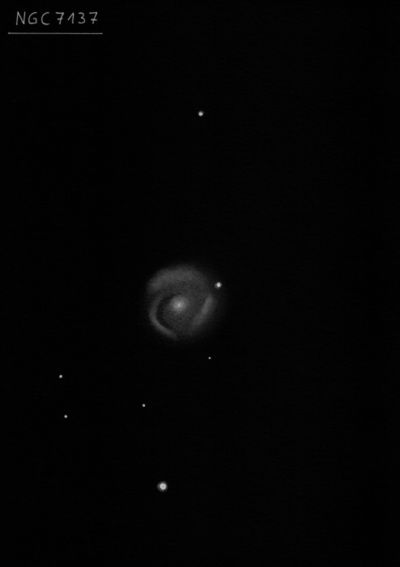
William Herschel discovered NGC 7137 = H II-261 = h2132 on 17 Nov 1784 (sweep 319) and logged "F, iR, less than 1' dia." JH made two observations, noting on sweep 166, "F; R; vglbM; 30"; r." His mean position matches UGC 11815.
200/250mm - 8" (8/5/83): very faint, small, round, diffuse.
300/350mm - 13.1" (8/5/83): fairly faint, moderately large, round. Fairly low surface brightness.
400/500mm - 17.5" (9/2/89): moderately bright, moderately large, oval SSW-NNE. Mottled appearance with an irregular surface brightness and an impression of knots involved.
Notes by Steve Gottlieb
NGC 7722
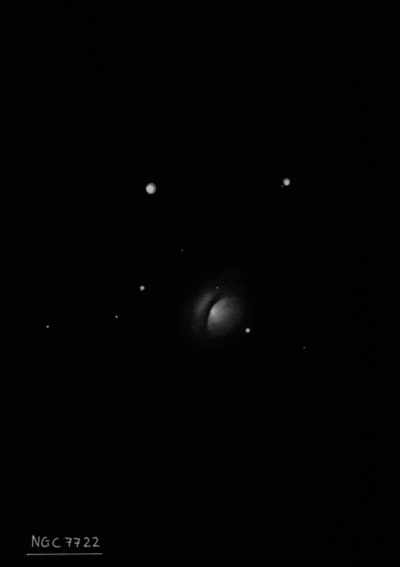
Heinrich d'Arrest discovered NGC 7722 on 12 Aug 1864 with the 11-inch refractor at Copenhagen. His position is accurate (observed on two nights) and he mentions the mag 12 star 2' NNE (3.8 seconds of time east and ~1.5' north).
400/500mm - 17.5" (10/28/89): fairly faint, fairly small, almost round, even concentration to a bright core, very small or stellar nucleus. A mag 15.5 star is close off the SW edge [44" from center].
Notes by Steve Gottlieb
NGC 7798
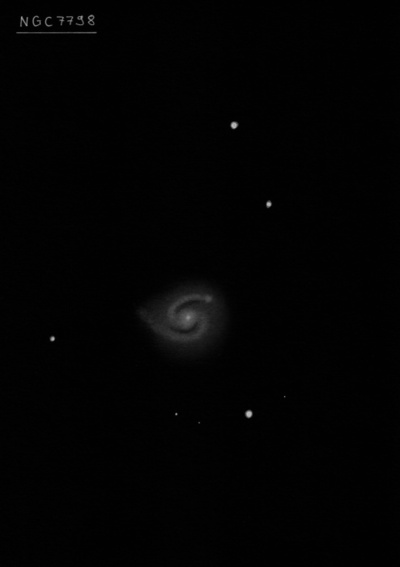
William Herschel discovered NGC 7798 = H II-232 = h2290 on 18 Sep 1784 (sweep 277) and recorded "F, S, R, or large stellar." He observed this galaxy again on 13 Nov 1786 (sweep 635) and noted "B, S, R, mbM, near a star." JH made the single observation "pB; S; R; bM; has a * 10m 60° sp, distance 65"."
400/500mm - 17.5" (7/20/90): moderately bright, fairly small, round, increases to bright core, faint stellar nucleus. A mag 11 star is 1.4' SSW of center.
Notes by Steve Gottlieb
NGC 7292
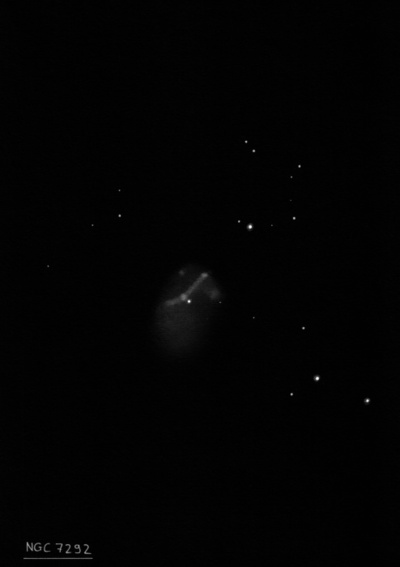
Édouard Stephan discovered NGC 7292 = St IV-12 on 6 Sep 1872. His micrometric position is very accurate.
400/500mm - 17.5" (9/2/89): fairly faint, moderately large, oval WNW-ESE, broad concentration. A group of mag 13.5-14 stars are off the NW end including a two mag 13.5 stars 1.2' NW and 1.8' NW.
900/1200mm - 48" (10/29/16): at 813x; bright, fairly large, very irregular appearance. A faint star is superimposed just south of a very small brighter nucleus or knot. A bright "bar" extends through the nucleus WNW-ESE, (length ~50"), ending at a fairly bright knot at its WNW end. The knot (HII complex/OB assocation?) appears ~10"x7" SW-NE. A low surface brightness halo on the north and south side of the bar is roughly oval 3:2 and increases the overall size to ~1.5'x1.0'. Situated in a fairly busy star field.
Notes by Steve Gottlieb
NGC 7800
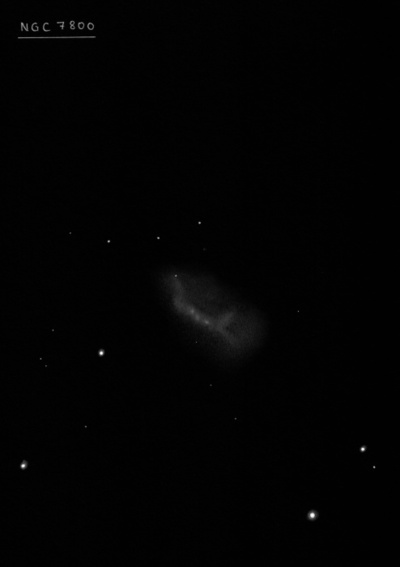
William Herschel discovered NGC 7800 = H II-10 = h2291 on 24 Dec 1783 (early sweep 62) and noted "a nebula, vF, E. Has two or three places in which I suspect vF stars." On 18 Sep 1786 (sweep 590) he logged "F, E, bM, pL, the extension not far from the meridian; from sp to nf." John Herschel apparently observed this galaxy on his first sweep of 2 Nov 1823, but didn't identify it later. On 12 Sep 1828 (sweep 175), he logged "F; S; E; irreg fig; 18"."
400/500mm - 17.5" (8/8/91): moderately bright, fairly small, elongated 3:2 SW-NE, weak concentration. A mag 13.5 star is 1.6' ESE and a mag 14.5 star is just off the NE end, 1.5' NNE of center.
Notes by Steve Gottlieb
NGC 7241
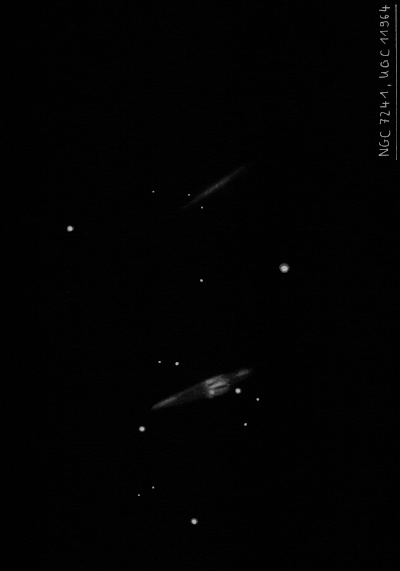
UGC 11964, an extremely thin and faint edge-on (1.9'x0.15'), lies 5' W. It was just glimpsed at 262x and 285x and was too faint to see its needle-like shape clearly, though occasionally was visible as a streak, perhaps 20"x6".
Édouard Stephan discovered NGC 7241 = St IV-10 on 3 Sep 1872. His RA is 16 seconds too large. Emmanuel Esmiol's re-reduced position (published in 1916) corrected this error. Bigourdan also measured an accurate position in 1887, which Dreyer published in the IC 2 Notes.
400/500mm - 17.5" (9/2/89): moderately bright, fairly large, very elongated or edge-on SSW-NNE. Asymmetric appearance as the galaxy appears brighter on the SSW end and very faint at the NNE end. A mag 11.5 star is just following the south end 0.8' from center and a mag 13 star is at the NW end. A mag 10 star lies 3.4' SW.
Notes by Steve Gottlieb
NGC 7436
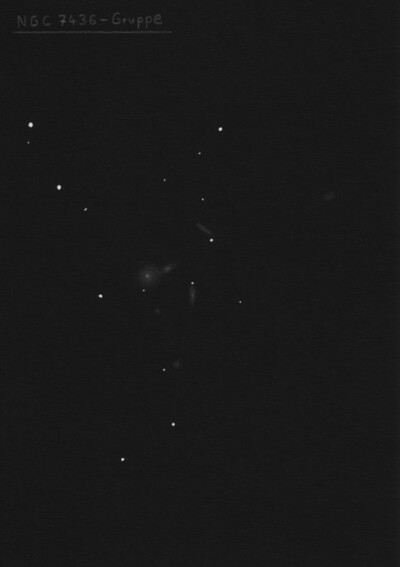
William Herschel discovered NGC 7436 = H III-243 = h2195 on 2 Dec 1784 (only object in sweep 327) and recorded "vF, S, er, but I have not been out long enough to see very well, and it may be only stars." On 18 Aug 1828 (sweep 167), JH logged "F; E in parallel; gbM; 60" l, 30" br." Although not resolved, the elongation was caused by the superimposed companion on the west side.
The RNGC identifies the brighter eastern component as NGC 7436A and the western component as NGC 7436B. The identification problems with this group (specifically NGC 7433 and 7431) are discussed in detail in the Oct 1989 Webb Society Quarterly Journal and in Malcolm Thomson's unpublished "Catalogue Corrections".
R.J. Mitchell discovered NGC 7436B = MCG +04-54-005 = PGC 70123 on 23 Oct 1855 and noted "3 neb; last one [NGC 7436] pB, bM, has either a star or nebulous knot closely p [NGC 7436]; ...." The "nebulous knot" is NGC 7436B. He observed the group again on 18 Sep 1857 and logged, "... closely p is a * or sharply defined nebulous patch, ..." Dreyer observed the group on 29 Sep 1875 and reported, "The object p in the diagram from 1857 is a F *. Night bad." Harold Corwin notes that based on Dreyer's own observation, he didn't assign the western component of NGC 7436 an NGC designation. NED identifies this galaxy as NGC 7436A and HyperLEDA calls it NGC 7436B.
400/500mm - 17.5" (8/25/95): brightest in a tight group of four galaxies including NGC 7431, NGC 7433 and NGC 7435. Fairly faint, small, round, 1.2' diameter. Well concentrated with a small, bright core. The view is confused by a companion, which is partially superimposed on the west side of the halo and creates the impression of elongation E-W. A mag 15 star is 50" SW and a mag 14.5 star 1.3' WNW.
17.5" (9/2/89): brightest in a group, faint, small, slightly elongated N-S, bright core. Forms a double system with NGC 7433 attached at the west end. In a group with NGC 7435 1.0' SW, NGC 7431 2' NW (not seen). Located 15' E of mag 8.9 SAO 90886.
600/800mm - 24" (7/20/12): brightest and central galaxy in a group with three extremely close companions. At 325x appeared moderately bright and large, round, ~1' diameter. Sharply concentrated and dominated by a very bright small core. The halo has a low surface brightness and gradually fades out, but seems to encompass NGC 7436B = VV 84b, which appeared as a faint or fairly faint thin spike, ~22"x8", emerging from the halo and extending west. NGC 7435 is just 57" SW and NGC 7433 is 1.5' NW. Also nearby are MCG +04-54-007 2.4' S, PGC 1766408 3.4' NW, NGC 7431 4.2' WNW and PGC 1768375 is 5.7' NNW.
MCG +04-54-007 is extremely faint or very faint, very small, round, 12" diameter. A mag 16.1 star lies 20" E. PGC 1766408 is extremely faint, very small, irregularly round, 15"x12". PGC 1768375 is extremely faint and small, round, 9" diameter. Collinear with a mag 15 star 0.7' NE and a mag 13 star 1.2' NE.
900/1200mm - 48" (10/26/16): brightest of a total of 8 galaxies observed within 4'. At 610x; bright, moderately large, round, sharply concentrated with a very bright small core, increasing to a stellar nucleus. The halo has a much lower surface brightness and contains NGC 7436B, which pokes out of the halo on the west side. The contact companion appeared moderately bright, fairly small, very elongated 3:1 E-W, 24"x8", very small bright nucleus.
Notes by Steve Gottlieb
NGC 7465
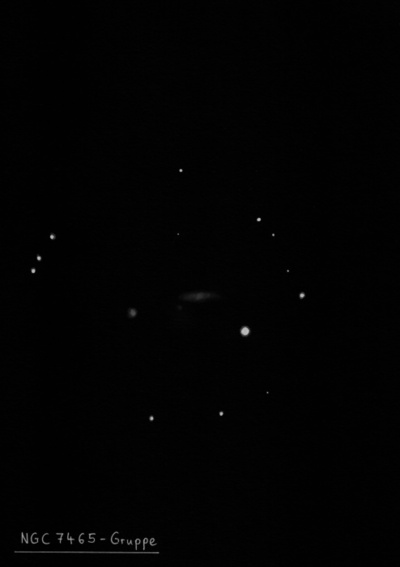
William Herschel discovered NGC 7465 = H III-211 = h2203, along with NGC 7463, on 16 Oct 1784 (sweep 294) and recorded "Two, the second of them [NGC 7465] stellar, both vF. The first NGC 7463] lE and a little larger than the second; both vF." JH measured separate positions for the pair. They both missed NGC 7464.
300/350mm - 13.1" (9/22/84): very small, round, stellar nucleus surrounding a small outer halo.
13.1" (9/3/83): fairly faint, very small, stellar nucleus, fairly high surface brightness. Only viewing the nucleus? Brightest in subgroup of three with NGC 7464 and NGC 7463. Located 27' E of NGC 7448.
400/500mm - 17.5" (9/14/85): fairly bright, small, bright core, stellar nucleus, slightly elongated 3:2 NNW-SSE. Brightest in a close trio with NGC 7464 1.8' WNW and NGC 7463 2.4' WNW in the NGC 7448 group.
900/1200mm - 48" (10/26/16): at 610x; bright, moderately large, oval NNW-SSE, ~0.9'x0.7'. There are three distinct brightness zones; the oval halo, a slightly elongated bright core, and a very small intensely bright nucleus. In an interacting triplet with NGC 7463 2.4' NW and NGC 7464 1.8' WNW. Mag 8.2 HD 217602 lies 4' WSW.
Notes by Steve Gottlieb
UGC 12914
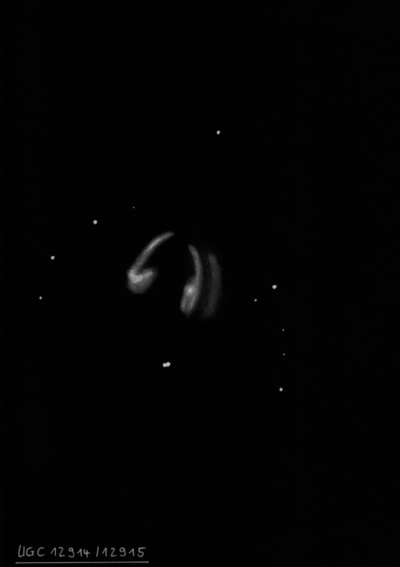
400/500mm - 17.5" (7/17/93): brighter of a close pair of UGC galaxies dubbed the "Taffy" galaxies. Faint, moderately large, edge-on 4:1 NNW-SSE, 2.0'x0.5'. A mag 12.5-13 star is at the SE tip, 1.6' from the center. UGC 12915 lies just 1' NE.
600/800mm - 24" (9/14/12): at 375x, the brighter member of the "Taffy" Galaxies appeared moderately bright, moderately large, very elongated 3:1 NNW-SSE, 1.0'x0.3', broad concentration with a brighter core. An extension (spiral arm) is attached on the NNW end and hooks towards UGC 12915, which is centered 1.0' NE. The arm increases the total size to ~1.6'x0.8' (roughly 2:1). UGC 14 lies 32' SE.
900/1200mm - 48" (11/1/13): the Taffy pair was observed at 610x. UGC 12914 (southwestern component) appeared bright, fairly large, very elongated 3:1 NNW-SSE, 2.1'x0.7', sharply concentrated with a very bright, rounder core. The southern end of the galaxy gradually faded out and extended further than seen with my 24". A dust lane creates a sharp light-cut off on the east side of the core and the diffuse glow from an arm is visible further east. A bright curving spiral arm is attached on the NNW side of the core and it hooks north counterclockwise towards the companion UGC 12915. The arms from both galaxies nearly merge in an embrace, but don't connect. A mag 13 star is just off the southeast end.
Notes by Steve Gottlieb
NGC 7673
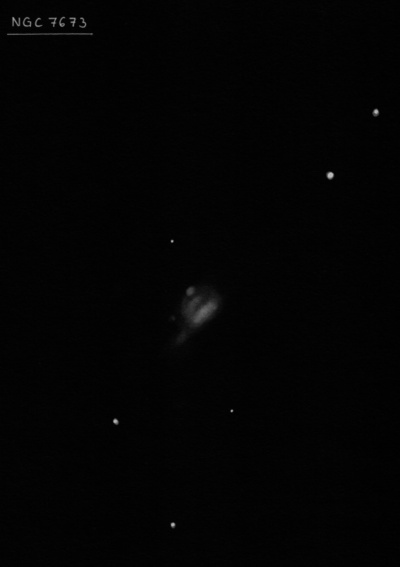
Albert Marth discovered NGC 7673 = m 577 on 5 Sep 1864 and noted "F, S, R." Heinrich d'Arrest independently discovered the galaxy again on 30 Sep 1866 with the 11" refractor at Copenhagen Observatory.
300/350mm - 13.1" (9/22/84): moderately bright, small, weak concentration, round. Forms a pair with NGC 7677 7' SE. Located 4' W of mag 7.9 SAO 91280 and 5' WNW of mag 8.6 SAO 91282. Upsilon Pegasi (V = 4.4) is 33' WSW in a low power field.
Notes by Steve Gottlieb
NGC 7610
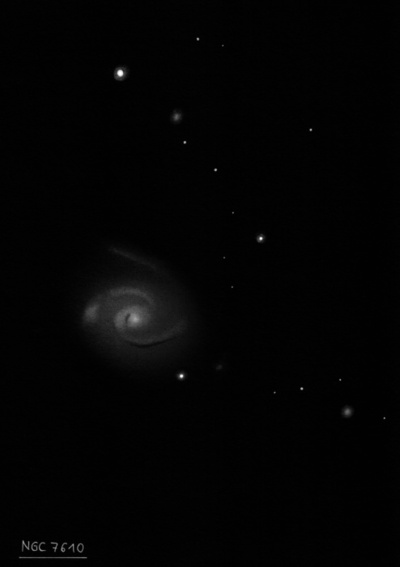
400/500mm - 17.5" (8/27/92): faint, moderately large, 1.5' diameter, low surface brightness, no central concentration. A mag 12 star is just off the southwest edge 1.1' from the center. Located at the north edge of the Pegasus I cluster.
Notes by Steve Gottlieb
NGC 7253
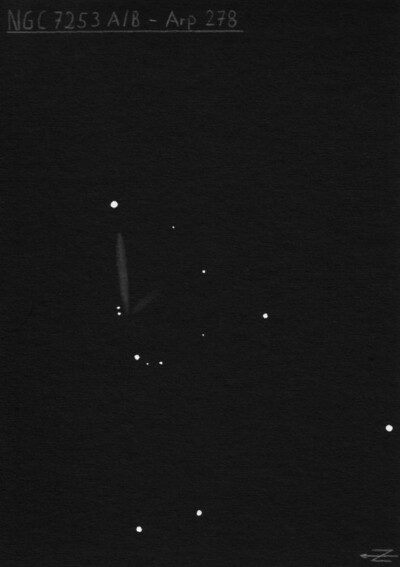
Albert Marth discovered NGC 7253 = m 471 on 9 Sep 1863 and noted "vF, pE." His position is accurate though apparently he did not resolved this close pair.
400/500mm - 17.5" (9/2/89): NGC 7253A is very faint, small, elongated WNW-ESE. Forms a double system (Arp 278) with NGC 7253B = VV 242b attached at the east end with a separation of 55" between center. The companion is extremely faint, small, elongated SW-NE. A pair of mag 15 stars is at the east edge.
600/800mm - 24" (7/24/14): NGC 7253 = Arp 278, a disrupted, interacting double system, was observed at 260x. NGC 7253A, the northwest component, appeared fairly faint, moderately large, elongated 5:2 WNW-ESE, ~50"x20". A mag 12.5 star is 1.3' WNW, collinear with the major axis. A 7" pair of mag 15 stars is barely off the ESE end. NGC 7253B is attached at the east-southeast end of NGC 7253A, very close to the faint double, and appears very faint, fairly small, elongated 2:1 SW-NE, 30"x15". A mag 13.3 star is 0.7' E. Situated in a rich star field.
Notes by Steve Gottlieb
NGC 7463
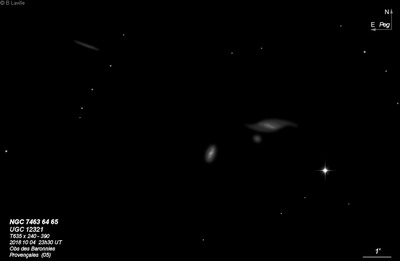
William Herschel discovered NGC 7463 = H III-210 = h2202, along with NGC 7465, on 16 Oct 1784 (sweep 294) and recorded "Two, the second of them NGC 7465] stellar, both vF. The first [NGC 7463] lE and a little larger than the second; both vF." Both Herschels missed NGC 7464 (discovered by d'Arrest).
300/350mm - 13.1" (9/22/84): fairly faint, fairly small, diffuse.
13.1" (9/9/83): faint, fairly small, elongated E-W, lower surface brightness than NGC 7464 45" SE.
400/500mm - 17.5" (9/14/85): fairly bright, very elongated 3:1 E-W, brighter core but no sharp nucleus. Lower surface brightness than nearby NGC 7465 2.6' ESE. In a close trio with NGC 7465 and NGC 7464 just 42" SE of center. Located 2.5' NE of mag 8.5 SAO 108339. Member of the NGC 7448 group.
900/1200mm - 48" (10/26/16): at 610x; very bright, large, very elongated at least 4:1 E-W, ~2.0'x0.5'. Unusual structure [nearly edge-on barred spiral] with a fairly bright bar angling across the central section ~SW-NE, ~25"x10". A spiral arm extends west of the bar and a long, low surface brightness tidal arm stretches to the east. NGC 7464, situated 0.7' SE, is just south of the beginning of the eastern arm. The stretched appearance is likely due to an interaction with NGC 7465 2.6' SE. These galaxy, as well as the two described below, are part of the NGC 7448 group.
UGC 12321, located 7' NE, appeared fairly faint, thin edge-on 6:1 sliver WSW-ENE, 35"x6", very small brighter core. A 2' length NW-SE string of 3 mag 11.5-12 stars is close south. The middle star is in this string is an uncatalogued double star with a separation of ~1.8". UGC 12313, located 5.5' NNW, appeared very faint to faint, moderately large, edge-on ~4:1 WNW-ESE, 1.2'x0.3', slightly brighter core, fades out at the tips, overall fairly low surface brightness.
Notes by Steve Gottlieb
NGC 7805
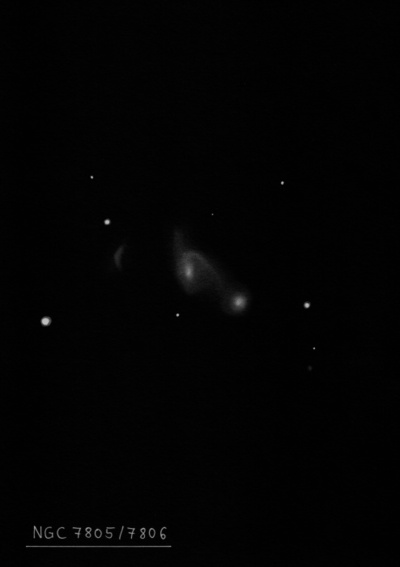
William Herschel discovered NGC 7805 = H III-855 = h2294, along with NGC 7806, on 9 Oct 1790 (sweep 971), and recorded "Two, eF, stellar, between 1' of each other, from 30° sp to nf." On sweep 178, JH reported "eF; S; R: sbM; double; the sp of 2."
400/500mm - 17.5" (11/14/87): fairly faint, very small, slightly elongated, bright core, stellar nucleus. A mag 13.5 star is 1.0' W. Forms a close similar pair with NGC 7806 30" off the NE edge and 54" between centers (the pair is Arp 112).
600/800mm - 24" (12/1/16): at 375x; moderately bright, fairly small, compact, very slightly elongated SW-NE, 25"x20", small bright core, very small bright stellar nucleus. Forms a similar double system (Arp 112) with NGC 7806 [50" NE between centers]. A mag 13.5 star is 1' W.
Notes by Steve Gottlieb
NGC 52
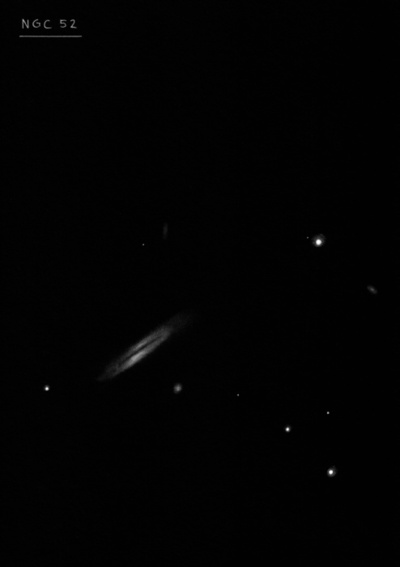
William Herschel discovered NGC 52 = H III-183 = h11 on 18 Sep 1784 (sweep 277) and recorded "eF, S, irr E." The NGC position is 0.4 min of RA east of UGC 140 = PGC 978. Bigourdan measured an accurate position on 13 Nov 1889 (repeated in the IC 2 Notes section).
400/500mm - 17.5" (11/14/87): fairly faint, small, thin edge-on 5:1 WNW-ESE, weak concentration.
Notes by Steve Gottlieb
NGC 7236
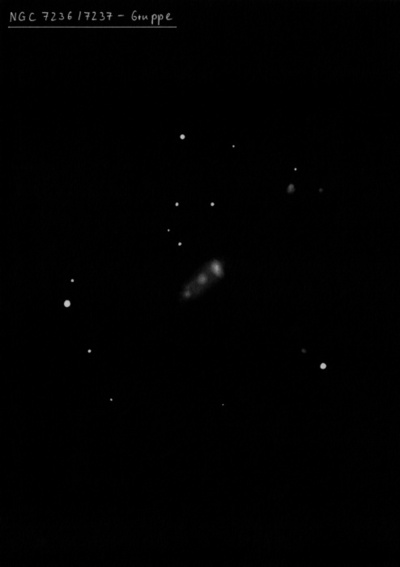
Albert Marth discovered NGC 7236 = m 468, along with NGC 7237, on 25 Aug 1864 and noted "vF, S, stellar." His declination is off by 1' (too far south). CGCG fails to label this double system as NGC 7236 + 7237. Malcolm Thomson mentions this omission in his unpublished CGCG Corrections.
400/500mm - 17.5" (8/20/88): first and brightest of three with NGC 7237 35" SE of center and an anonymous galaxy 1.2' SE, all equally spaced on a NW-SE line. Appears faint, very small, round, small bright core, in a common halo with NGC 7237. Located 2.7' NE of a mag 10 star. The trio forms Arp 169.
600/800mm - 24" (9/27/14): first and brightest in a linear trio (Arp 169) with a total length of only 1.2'. At 375x, NGC 7236 appeared fairly faint, very small, round, compact, high surface brightness, 18" diameter. Forms a very close pair with NGC 7237 just 35" SE. A trio of mag 14 star is to the N and NE and a mag 10 star is 2.7' SW.
Brightest in the poor cluster WBL 678 with CGCG 428-057 5.5' SW ("faint, very small (core), round, 12" diameter"), UGC 11953 13' WSW ("faint, very thin streak, 30"x6", even surface brightness"), CGCG 428-049 15' WSW ("very faint, very elongated 7:2 NNW-SSE, 27"x8", even surface brightness") and CGCG 428-054 8.5' NW.
Notes by Steve Gottlieb
IC 5378
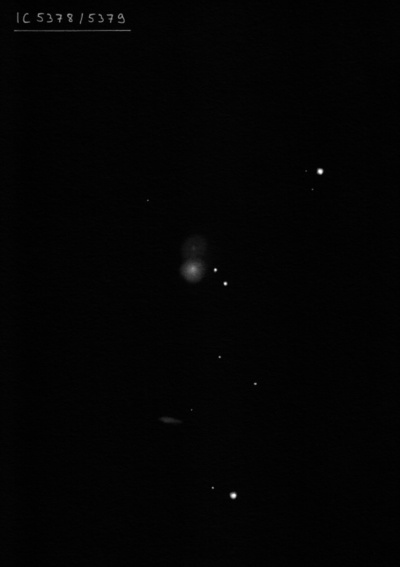
Isaac Roberts discovered IC 5378, along with IC 5377 and 5379, on a plate taken on 17 Nov 1895 of NGC 7814. He described IC 5378 as "Faint; elongated north to south; one of three 15th mag stars involved; condensation at the north extremity; length including the star about 42"." His position is 1.3' too far south (same as IC 5379), but his description is very accurate (except the involved mag 15 star is the nucleus).
400/500mm - 18" (11/14/09): faint, small, round, 20" diameter, two mag 14 stars [23" separation] are close preceding [nearer star is 30" west]. A much fainter companion (MCG +03-01-016 = PGC 178) attached on the north side was not seen. Located 30' NNW of NGC 7814.
600/800mm - 24" (12/1/16): fairly faint, small, round, 15"-18" diameter, slightly brighter nucleus. A 20" pair of mag 14.5 stars is off the west side. MCG +03-01-016, a very low surface brightness companion adjacent to the north [30" between centers], was not seen.
Notes by Steve Gottlieb
NGC 7770
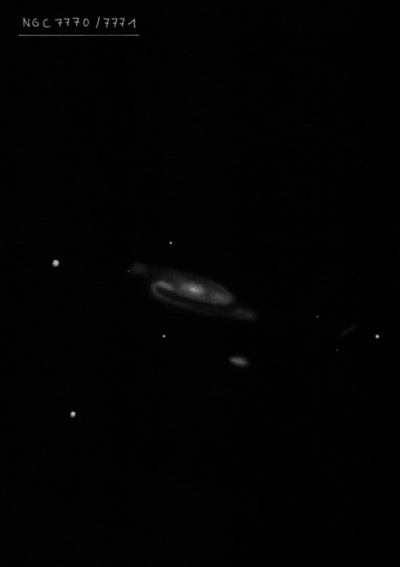
William Herschel noticed NGC 7770 on 18 Sep 1784 (sweep 277) in his discovery of NGC 7771. He commented, "towards the sp part [of NGC 7771] seems to be a vS stellar nebula within the nebulosity of the large one, but it may be only a small star." Due to his uncertainty he didn't assign NGC 7770 an internal discovery number or H-designation, so received no later credit.
John Herschel independently found this galaxy on 25 Aug 1827 while observing NGC 7771. His description on sweep 91 reads, "pB; E; bM; has a vS almost stellar nebula about 45° sp, dist 40"." On the following sweep, he made a sketch and noted "... has a smaller neb, 60° sp, 35" dist." Wolfgang Steinicke mentions that JH used object class "N2" (two nebulae), so it's surprising he didn't assign NGC 7770 a separate designation in the Slough or General Catalog. As a result, JH received no credit in the GC or NGC.
George Johnstone Stoney, Lord Rosse's assistant, discovered NGC 7770 agaom on 5 Nov 1850 while observing NGC 7769 and 7771. A sketch of the trio was included in the 1861 publication (NGC 7770 is labeled Gamma). A more accurate sketch from 1855 is on plate V of the 1880 publication. Lord Rosse is credited with the discovery of NGC 7770 in the GC and NGC.
300/350mm - 13.1" (9/9/83): very faint, very small, round. Forms a close pair with NGC 7771 1' SSE.
400/500mm - 17.5" (8/31/86): fairly faint, slightly elongated, brighter core. Forms a double system with much brighter NGC 7771 just 1.1' NNE in the NGC 7769 group.
600/800mm - 24" (10/5/13): moderately bright, fairly small, elongated 5:3 SSW-NNE, 0.5'x0.3', contains a small bright core. Forms a close pair with much larger NGC 7771, 1.1' NNE.
Notes by Steve Gottlieb
NGC 7587
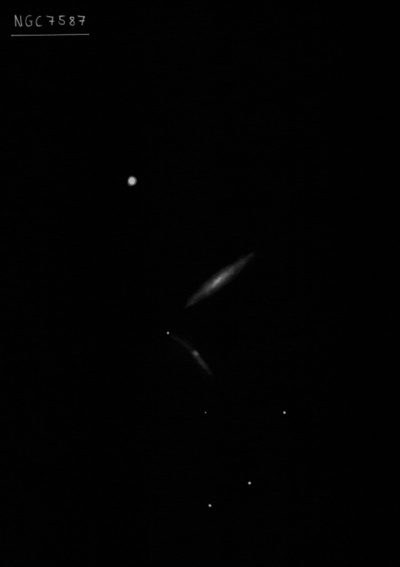
Albert Marth discovered NGC 7587 = m 558 on 5 Oct 1864 and noted "vF, vS, lE, gbM." His position is accurate.
400/500mm - 17.5" (10/28/89): faint, fairly small, very elongated NW-SE, weak concentration. Forms a close pair with CGCG 406-051 0.9' S. The companion is extremely faint and small, round. At z = .029, this galaxy is twice the redshift of the main members of Pegasus I, so perhaps is a member of the Pegasus II cluster.
600/800mm - 24" (9/30/16): moderately to fairly bright, very elongated 3:1 NW-SE, ~50"x18", high surface brightness, small bright core. A mag 11 star is 2.5' NE. Forms a close pair with CGCG 406-051 [51" between centers]. The companion appeared very faint, small, elongated 2:1 SW-NE, 20"x10".
Notes by Steve Gottlieb
UGC 12856
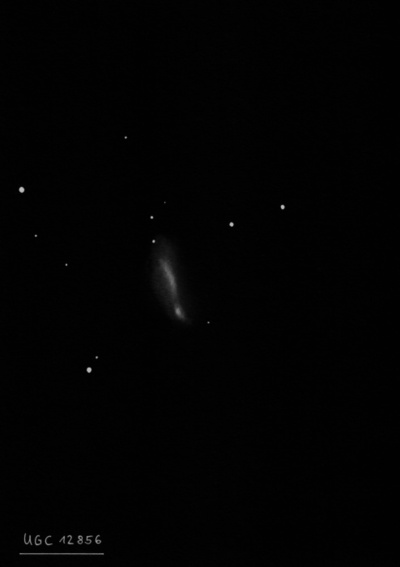
400/500mm - 18" (10/29/11): at 225x, appeared faint to fairly faint, fairly small, elongated 2:1 N-S, 36"x18", low even surface brightness. At 283x, a very small glow or knot (MCG +03-01-003) was glimpsed at the south end or slightly west of the main elongated glow.
18" (9/26/11): faint, fairly small, elongated nearly 3:1 NNW-SSE, 45"x18", low nearly even surface brightness, appeared to have a very slightly brighter core. Need better conditions to confirm the companion galaxy, though a slightly brighter spot at the south end was suspected a few times.
Notes by Steve Gottlieb
UGC 6
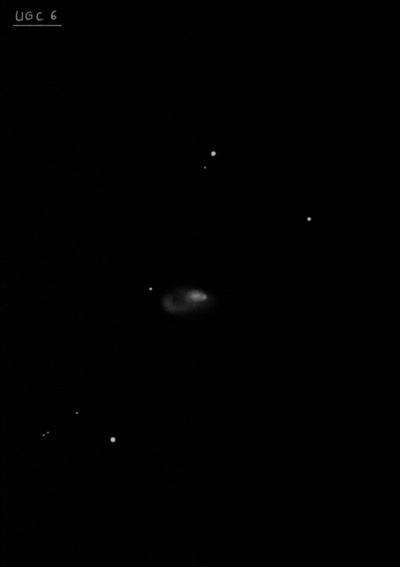
600/800mm - 24" (9/14/12): at 324x, fairly faint, small, slightly elongated, 25" diameter, sharply concentrated with very small bright core. A mag 14.9 star lies 40" ENE. UGC 11 lies 9' NNE. UGC 6 = IV Zw 1 is an interacting Seyfert galaxy with a single loop or tidal arm on the southeast end (not seen).
Notes by Steve Gottlieb
UGC 12127
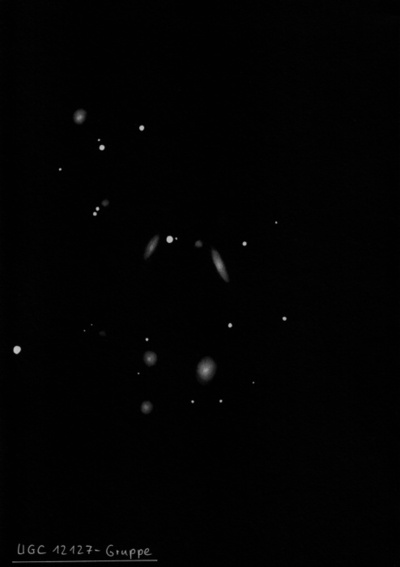
400/500mm - 17.5" (8/12/88): fairly faint, round, bright core. Brightest in the UGC 12127 group. Several companions are nearby including MCG +06-49-056 = CGCG 514-078, MCG +06-49-061 = CGCG 514-081 and MCG +06-49-060 1' NE.
600/800mm - 24" (8/31/16): moderately/fairly bright, fairly small, irregularly round, 40" diameter, contains a bright core that increases to the center. Brightest in an excellent group of galaxies (WBL 685) including MCG +09-49-060 1.3' NE, MCG +09-49-062 1.7' E, MCG +09-49-056 2.3' NNW, MCG +06-49-061 3.0' N.
Notes by Steve Gottlieb
NGC 7474
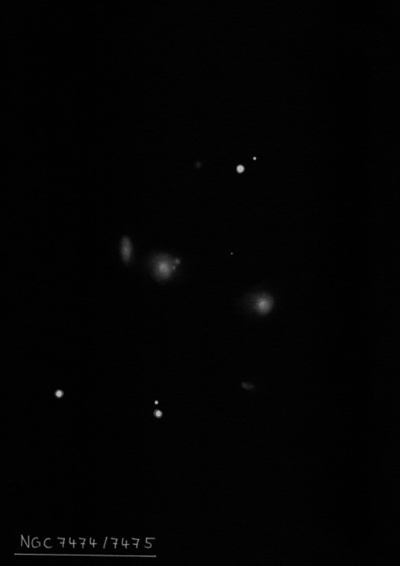
Albert Marth discovered NGC 7474 = m 517, along with NGC 7475, on 9 Sep 1864 and noted "eF, vS." His position is accurate.
400/500mm - 17.5" (9/2/89): very faint, extremely small, round. A mag 11 star is 2.0' N. Forms a pair with NGC 7475 1.6' NE.
600/800mm - 24" (9/10/15): faint to fairly faint, small, round, 18" diameter, stellar nucleus. First in a trio with NGC 7475 1.6' NE (double system with MCG +03-58-028). A mag 11.5 star lies 2' N and a wide pair (~15") is 2.8' SE.
Notes by Steve Gottlieb
NGC 7468A
The SDSS image reveals an apparent interacting pair with a distorted blue looping galaxy on the south side. Somewhat similar appearance to UGC 10402 = VV 560.
600/800mm - 24" (8/30/16): at 375x; faint to fairly faint, fairly small, elongated roughly 2:1 ~N-S. There appears to be a brighter knot at the north end that bulges out to the northwest. On the SDSS this feature appears to be the nucleus of the galaxy or the northern component of two distorted, interacting galaxies. An unequal 5" to 6" double star [mag 11-11.5 primary] is 3.3' NE. Located 7.3' NNW of mag 6.4 HD 218101. UGC 12350 lies 13' NE.
Notes by Steve Gottlieb
HCG 93
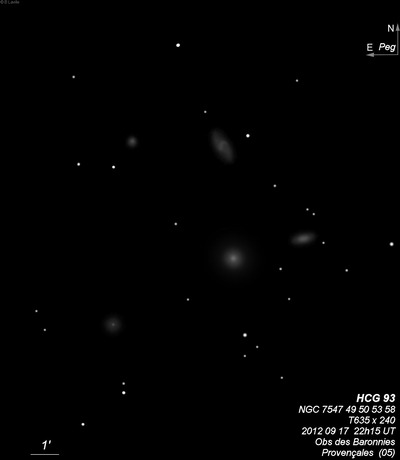
| Type | GALCL [E3] |
| RA | 23:15:24.2 |
| Dec | +18:58:59.0 |
| major_axis | 11.7' |
| mag | 10.9 |
| surface_bright | 99.9 |
HCG 92
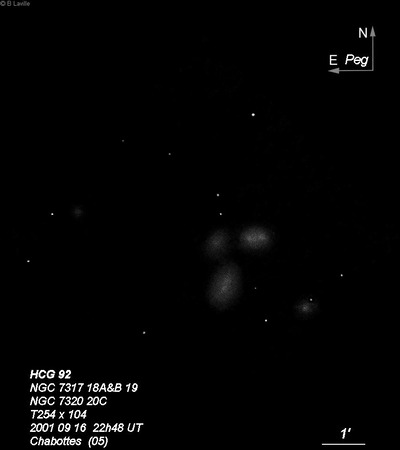
| Type | GALCL [S2] |
| RA | 22:36:00.5 |
| Dec | +33:57:57.0 |
| major_axis | 4.2' |
| mag | 11.1 |
| surface_bright | 99.9 |
HCG 96
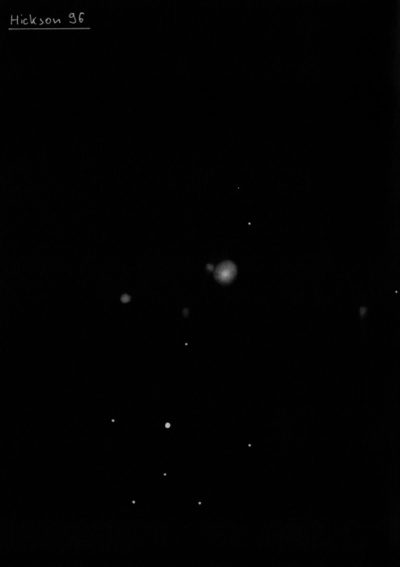
| Type | GALCL [S2] |
| RA | 23:27:58.3 |
| Dec | +08:46:27.0 |
| major_axis | 3.0' |
| mag | 11.5 |
| surface_bright | 99.9 |
HCG 100
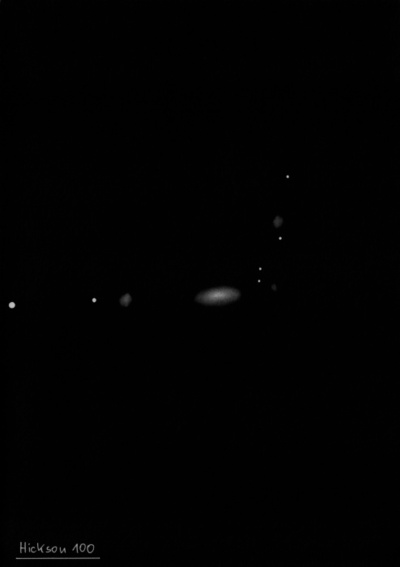
| Type | GALCL [S1] |
| RA | 00:01:20.8 |
| Dec | +13:07:57.0 |
| major_axis | 4.7' |
| mag | 11.5 |
| surface_bright | 99.9 |
HCG 95
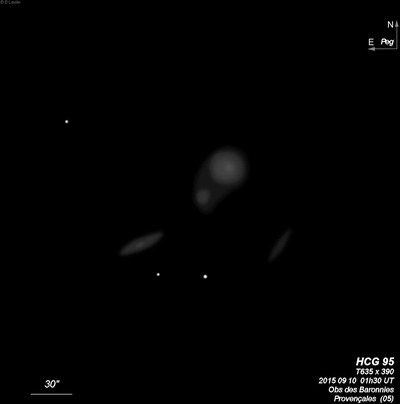
| Type | GALCL [E3] |
| RA | 23:19:31.8 |
| Dec | +09:29:31.0 |
| major_axis | 2.0' |
| mag | 11.9 |
| surface_bright | 99.9 |
HCG 99
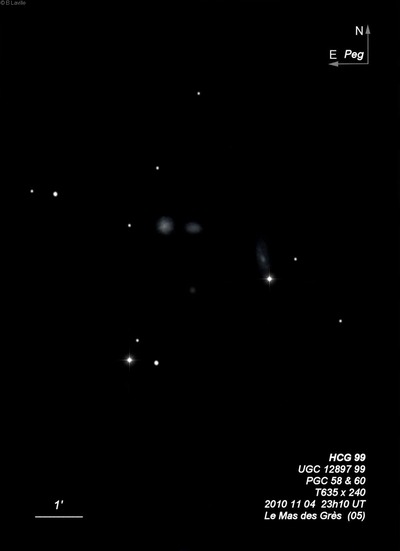
| Type | GALCL [S2] |
| RA | 00:00:43.7 |
| Dec | +28:23:20.0 |
| major_axis | 3.1' |
| mag | 12.2 |
| surface_bright | 99.9 |
HCG 94
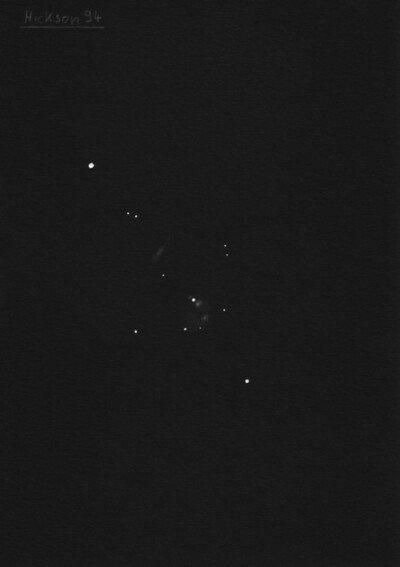
| Type | GALCL [E1] |
| RA | 23:17:16.5 |
| Dec | +18:43:11.0 |
| major_axis | 3.6' |
| mag | 12.3 |
| surface_bright | 99.9 |
Abell 2634
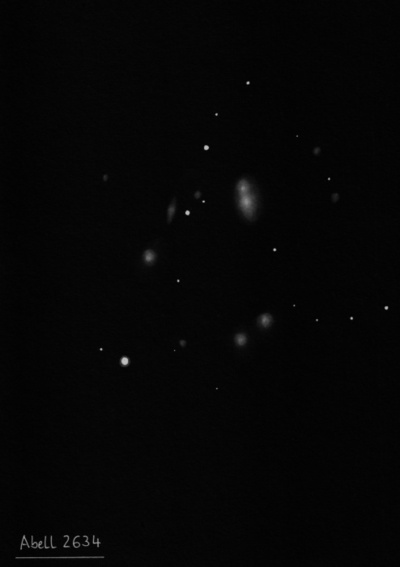
| Type | GALCL [11II] |
| RA | 23:38:18.0 |
| Dec | +27:01:00.0 |
| major_axis | 22.4' |
| mag | 13.8 |
Abell 2666
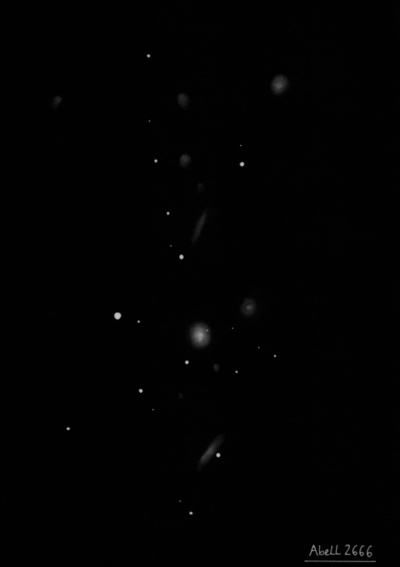
| Type | GALCL [01I] |
| RA | 23:50:54.0 |
| Dec | +27:08:00.0 |
| major_axis | 78.4' |
| mag | 13.8 |
Pal 13
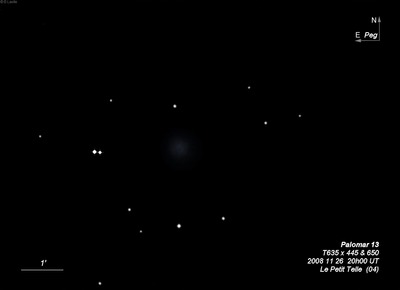
| Type | GC [XII] |
| RA | 23:06:42.0 |
| Dec | +12:46:00.0 |
| major_axis | 42.0'' |
| mag | 13.8 |
| surface_bright | 12.8 |
Jn 1
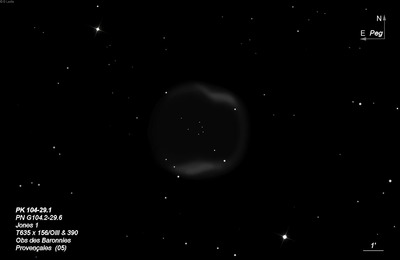
| Type | PN [3b] |
| RA | 23:35:53.3 |
| Dec | +30:28:06.0 |
| major_axis | 5.3' |
| mag | 15.1 |
| surface_bright | 18.5 |